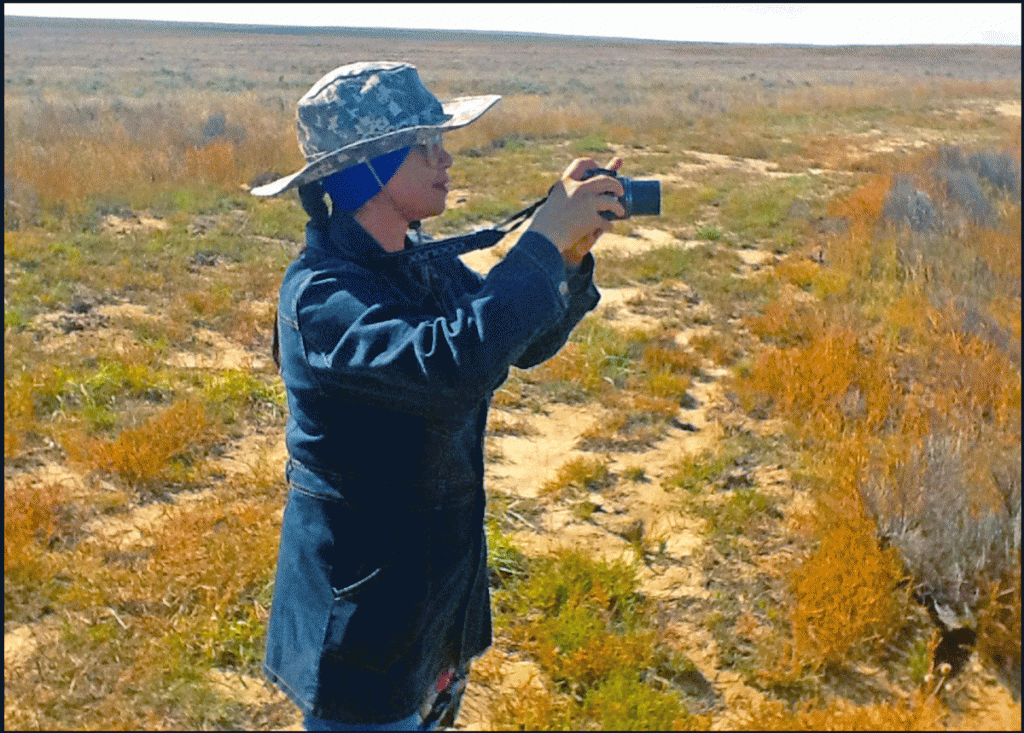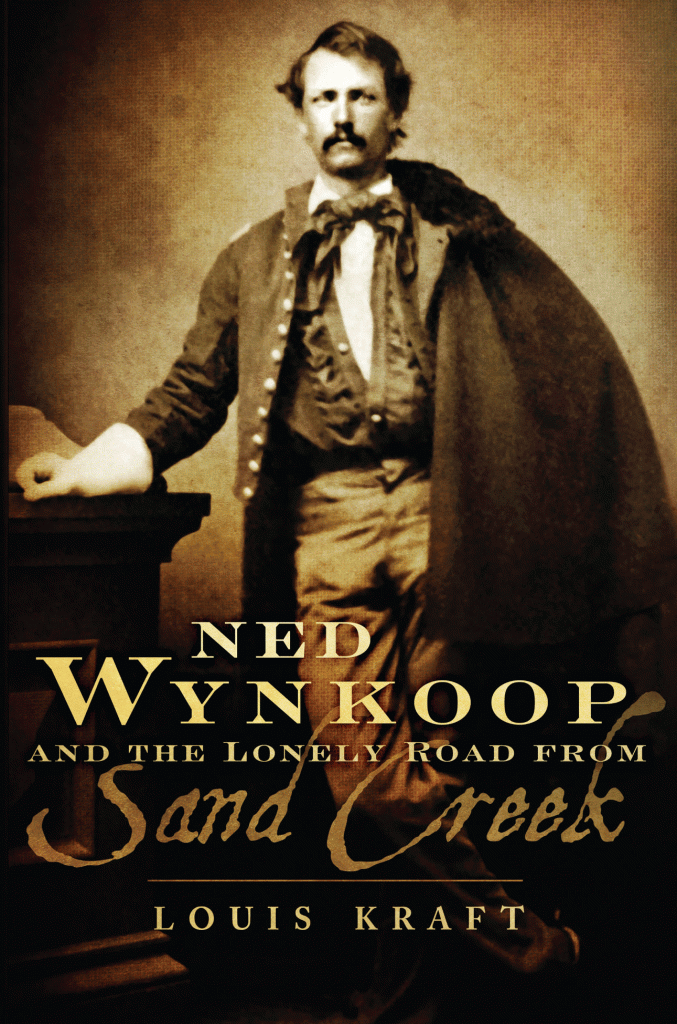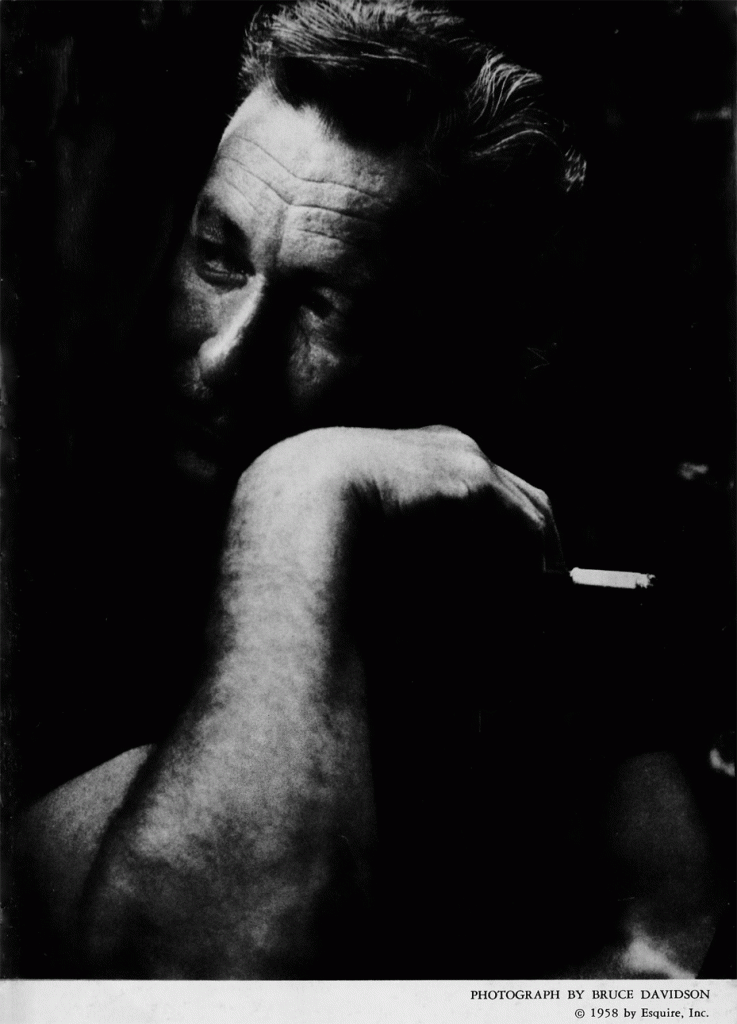1st sixth of a Louis Kraft 60-film list
Posted May 14, 2019
Website & blogs © Louis Kraft 2013-2020
Contact Kraft at writerkraft@gmail.com or comment at the end of the blogs
It is time to move from my Indian wars/race passion
to the world of film, my other passion, and
a blog that I announced in days
long past.
Alas, the long proposed 60-film list has been split
into six installments due to time limitations.
None of the choices made the first sixth of this 60-film list with only one screening.
A major fact
A film must grab and hold my interest from beginning to end. And just as
important I must care about at least one character
and preferably two or more.

This detail of a photo was taken in August 2018 when Pailin shot a series of photos for the University of Oklahoma Press marketing department. I’ve used it elsewhere on social media and like it better than some of the images I delivered to the press last summer. (photo © Louis Kraft and Pailin Subanna-Kraft 2018)
So you know: I study film all the time. Yes, it is for enjoyment, it is when I exercise (or bathe—you snicker and the next time we get together you’ll experience a real evil eye), and it is when I’m looking for something that shows me a way to make a smooth transition in my writing. … It is the perfect medium to see good and bad dialogue, good and bad transitions, and good and bad plots. … I learn as much from the bad as I do from the good. What follows is a living list, and it will grow and change as I move through life. What is here today may not be here tomorrow. This said, and because I’m wordy and time is short this list has been cut into six pieces. The second installment will appear as soon as possible.
LK film lists & opinions that mean nothing
I should tell you up front that I have little respect for most reviews I read. They are opinion, and often they include the reviewer’s bias. I get the Los Angeles Times (the Times was a great newspaper and perhaps will again be so under its new management). Most of my film viewing today is on DVDs or the internet. Currently the paper has two extraordinary film critics (Justin Chang and Kenneth Turan). Even so, I often disagree with them. No big deal, for I often disagree with my view of films. I’m just like everyone else. My view of movies is opinion—nothing more and nothing less. Read it with a grain of salt. Hopefully it may influence you to see some of the films on this list.
Lists change
Certainly my film lists are in constant flux. Sometimes a film or a performance doesn’t hold up over the passage of time. And this is certainly true as films from the Golden Age of Cinema (which will soon become a major focus of future books) have little representation in this list of 50.
I don’t own a TV, and “Frankly, my dear, I don’t give a damn,” to quote Clark Gable from Gone with the Wind. (David O. Selznick/MGM 1939). BTW, this film bores me to tears and yet I will be studying it with a fine-toothed comb in the very near future (see Olivia de Havilland celebrates her 100th birthday + an example of bunk if you don’t already know the reason).
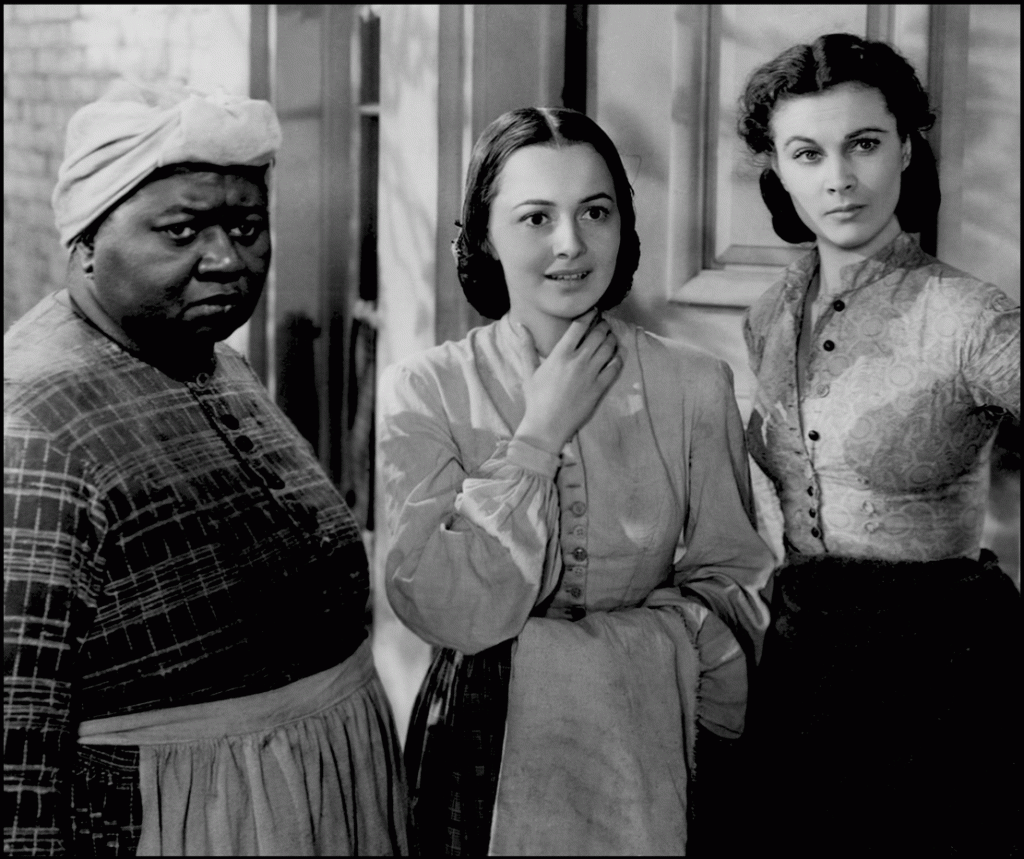
From left: Hattie McDaniel, Olivia de Havilland, and Vivien Leigh in Gone with the Wind. All three would receive Oscar nominations. McDaniel and de Havilland for supporting actress, and Leigh for lead actress. Vivien and Hattie won, and Olivia was devastated, although years later she changed her view and was thrilled that Hattie was honored. LK personal collection.
One blazing inclusion will be Olivia de Havilland’s The Snake Pit (20th Century Fox, 1948 ) along with one other guaranteed film (and perhaps two) that didn’t make an LK’s top 13 Errol Flynn films a couple of years back. For years The Snake Pit has been on and then off this list of films. Two reasons stand out: it is a hard film to view for its subject matter takes no prisoners and it is not a feel good story. At the same time it gives us Ms. de Havilland’s best screen performance of all time (no other performance of hers comes close to capturing how magnificent her acting capabilities really were). The film was extraordinary for 1948. If Olivia was thirty-two (her age when the The Snake Pit was released) in 2019 and the film was made today one can only wonder what the final product would have looked like, what she would have exposed to the camera for public viewing, and how you and I would have reacted to her performance. My view, and let me tell you that I disagree with easily 90 percent of the Oscar awards for acting and screenwriting, she was robbed for her performance as Virginia Cunningham was before its time at the end of the 1940s and it still is today.
The last two films in this 60-film list
For films at the bottom fifth of the list there is another problem, and doubly so as they won’t be shared until after four additional film blogs have been posted first. Simply this means that two really good films will never be selected as numbers 59 or 60 are firmly in place, and they’re never going away.*
* Hints: Singing while riding a Harley Davidson motorcycle and the pirate Drake. I had linked two spoilers here but changed my mind. I do love being a tease.
Wonder Woman, other films, & Hollywood kissing itself on its rear end
Wonder Woman? What the (expletive)! Yeah, Wonder Woman. Digest this!

Pailin Subanna-Kraft inside the Egyptian Theatre in Hollywood, Calif., just before she saw Errol Flynn’s last A-film The Roots of Heaven (20th Century Fox, 1958) on 15may2014. And … AND … she sat between Errol Flynn fan RF and myself at this screening. She told me that she was able to follow the story, which dealt with the preservation of elephants. (photo © Pailin Subanna-Kraft and Louis Kraft, 2014)
Let’s start with Pailin. … Her English grows with leaps and bounds, and this is on a daily basis. Still, when I show her films on the computer and when we see a movie in a theater I try keep the choices to basically western, action, and thriller (although this changed last year). Reason for these choices: Less dialogue, the action often moves the story to conclusion, and I like the above stated genres.
My gorgeous woman (Pailin) works way too-many hours while I’m chained to my computer working on getting the Sand Creek manuscript published and still punch out a blog now and again. Who knows, but perhaps some day I will return to a time currently gone but something that I dearly miss—writing magazine articles and giving talks. Pailin and I are two busy people, but we need a little R&R once in a while. A couple of years back I proposed seeing Wonder Woman to her, a film genre that I have great distaste for and avoid seeing. My proposal to my lady was based on film hype, no other decent films playing in LA, and the current trailer that I showed her, along with a decent review of the film (which, again didn’t mean much).

Pailin took this closeup image of a lighted (that is not a paper) poster of Gal Gadot as Wonder Woman, which was across the hall from the AMC 16 Burbank Theater screening room where we saw the film.
As is well known, Diana, “Wonder Woman,” was a DC Comics character. I’ve known that this film, directed by Patty Jenkins, was coming, and had for some time.
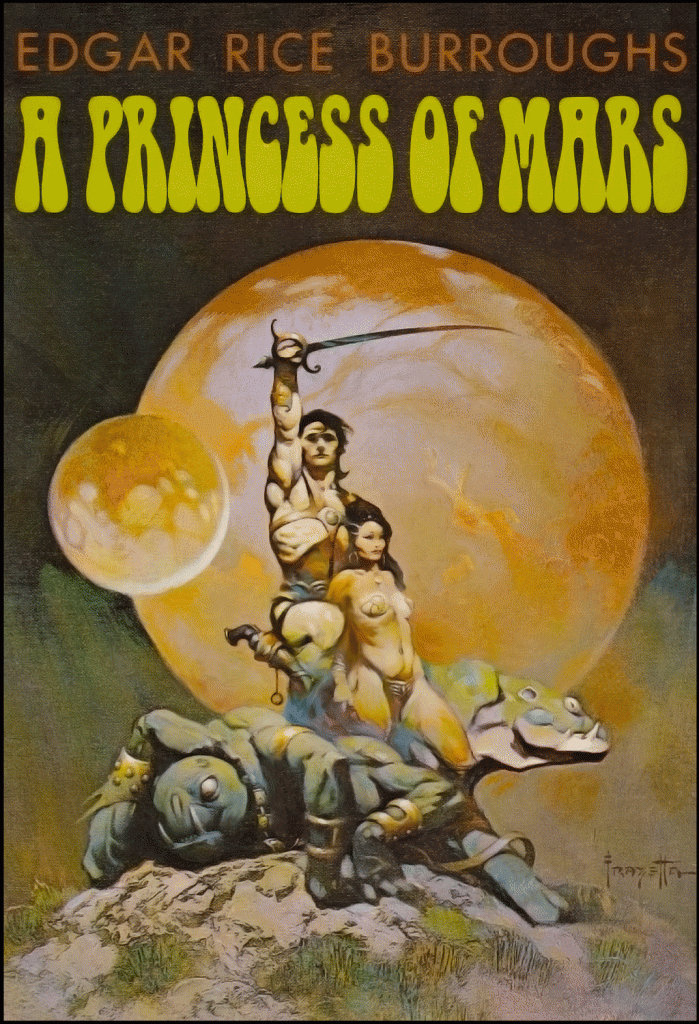
This book cover dust jacket art is by the late, and great, illustrator, Frank Frazetta (1912: Reprint; 1970 in a bookclub edition of the novel. I’ve liked Frazetta’s work since I discovered him while in junior high school and gobbled up Burroughs’ multitude of books that were then experiencing a mass-market paperback bonanza. … A film, John Carter (2012) was based somewhat on this novel (but unnecessarily updated). It had great production value, and an okay John Carter (Taylor Kitsch), but a lifeless and sexless Dejah Thoris (Lynn Collins), and I’m being kind to the lady here. The novel had a lot of sexuality and nudity; zero in the film, which still should have succeeded. Its advertising murdered it for it didn’t let a potential audience know the story’s roots and where the storyline was headed. Too bad. This film had been on an LK top 60 film list, but was banished over two years ago. Pailin has seen it in the Kraft theater and liked it. I like it too, just not Collins’ Dejah Thoris. Yuk! When you have a major player in a film and they don’t show up you have nothing. Will I ever change my mind about Collins’ dismal portrayal as Dejah Thoris?
I was pulling for Pailin to agree. … She did, and on June 3, 2017, I stole her away to see WW in a movie theater. Yeah, we went out on a date.
Wow! To steal from what I said elsewhere on social media: “All I want to say here is this is a good film. It had a plot, character development, decent characters performed by good actors, acceptable dialog, and you know what—I was on the edge of my seat during the entire film. I laughed, I smiled, I was thrilled, and I actually shed a few tears.” … Wonder Woman had been in the running to make this film list. Although it still is the only super-hero film that I’ve seen and liked it didn’t make the list. Perhaps as I’ve only seen it once,but most likely it’ll never make a Kraft film list.
Know that I am not a fan of pulp fiction, other than Edgar Rice Burroughs’ (of Tarzan fame; Tarzana, a town in Los Angeles in the San Fernando Valley, is named after his creation) eleven-book series on John Carter of Mars. The first book in the series hooked me for all time, A Princess of Mars, and her name was Dejah Thoris. A great series, although the last two or three books weren’t as good as the earlier ones.
I also want to mention an extraordinary film, War for the Planet of the Apes (20th Century Fox, 2017). It is science fiction but much more—much-much more.
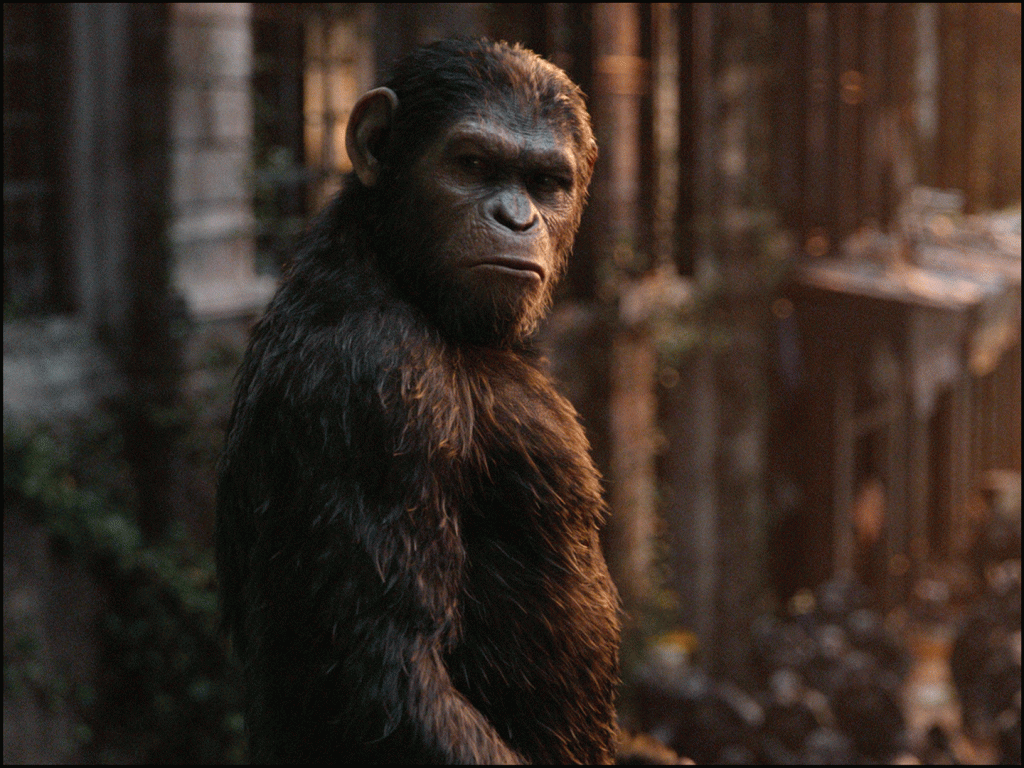
Andy Serkis as Caesar in War for the Planet of the Apes. LK personal collection.
It is a story of survival and racism, and when we get to the 60 films you’ll see that people of different races play a major role in my choices. This was not pre-set, it just happened when I viewed, then viewed again and again as I studied the films that made this list. I’ve only seen War for the Planet of the Apes once and that was in a movie theater.
Andy Serkis’ work as Caesar, the leader of the apes in their revolt for freedom in War for the Planet of the Apes, was created using CGI. I’m not going to get technical but Serkis and the other ape actors performed while wearing special clothing and had devices attached to them allowing their actions be captured which in turn permitted the special effects team to use their reactions and emotions while turning them into apes. Serkis and the other actors’ work shines and his or one of the other performances should have been recognized during the god-awful four-five months of pure hell time in Los Angeles when money buys awards for films that are stuffed down our throats on a daily basis.
My view on Hollywood kissing itself on its ass for a third of the year every year isn’t printable

Steven Spielberg photo by Patrick T. Fallon for the Los Angeles Times (it appeared in the California section of the paper on 3mar19, pB8).
If those in power used the money that they waste in Los Angeles every year where it was needed there would be no homeless problem (I can give you 30,000 words on this subject). No, instead they buy awards (which is similar to buying elections). Oops! That just popped out.
Mr. Spielberg was upset that Roma won three Oscars (it was nominated for 10). As far as he was concerned it streamed on TV, and even though it had the required number of days playing in movie theaters he considered it little more than a TV film. I can’t comment on Alfonso Cuarón’s Roma as I haven’t seen it (I haven’t seen Green Book or any of the other films that were nominated for Best Picture with the lone exception being A Star is Born). BTW, Cuarón won three Oscars for Roma (directing, cinematography, and best foreign film) and previously won two others in 2014 (for directing and editing Gravity). I wonder if Mr. Spielberg is jealous. Jealous or not, my take on him is that perhaps he complains too much. Why not speak out about the millions upon millions of dollars that are wasted every year to win an Oscar (take a look at the amount of money spent, and that includes for Mr. Spielberg’s films over the decades). I guess it’s okay to buy awards, but don’t you dare stream a film while also forking out big bucks as you may have an advantage over the poor-poor-poor film companies that refused to move forward with how films are viewed today. As Jeff Daly (West Hollywood) wrote in a letter to the Times (published on 10mar19): “As the Academy Awards attempts to stay relevant, he [LK: Spielberg] proposes to constrict, rather than expand, the scope of what constitutes an Oscar-worthy film.” I agree with Mr. Daly.
Andy Serkis deserved to be nominated for his performance. Yes, his performance was that good, and so were some of the other ape characters in the film. … Better, War for the Planet of the Apes was a story of survival, a story of caring and humanity. It was also a story of war, and it is tragic. My first impression: this is a great film. Will it make the list before the other four blogs are posted? I don’t know, but as stated above I need to see it more than once.
A lot of good films aren’t going to make this list.
Lady Gaga and A Star is Born
I don’t know Lady Gaga’s music; don’t think I ever heard her sing until I saw A Star is Born. My lone memory of the lady was at the 2016 Golden Globe awards, which I only saw clips of on the internet. She won an award and while making her way to the stage she bumped Leonardo DiCaprio’s back. He looked around to see who hit him, then turned back to his table with a huge grin on his face. I have no intention of interpreting what went through his mind at that moment, but I can guess and it was priceless.
The young Lady Gaga had posed for what might be considered risqué images but they were artistic and I think not offensive in any way. However, when compared to the painted person who created an ultra-persona that shot to mega-music stardom with her writing and singing is something that this ol’ cowboy missed. Everything: The massive hits, the multitudes of awards, and a celebrity that is extraordinary.
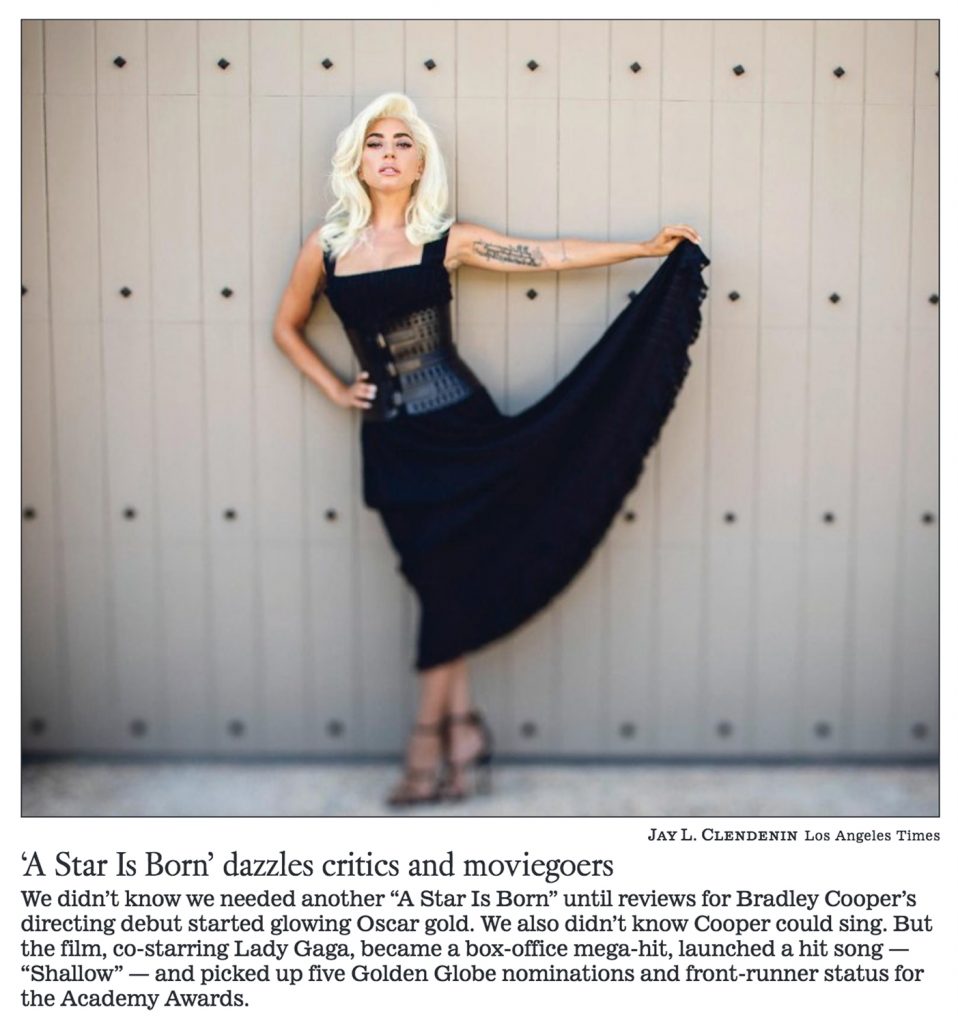
This image of Gaga is from a Los Angeles Times ad section that was devoted to film awards (28dec2018). Lady Gaga, just like my lady, knows how to pose for the camera.
I took Pailin to see Bradley Cooper’s directing debut while playing the jaded and on the downside rock-country star that Kris Kristofferson created in the 1976 Barbra Streisand film of the same name (which was the third reincarnation of the story of an up-and-coming talent who meets and teams with a major star spiraling, for lack of better words, toward the end of life).
I viewed the coming attraction for Cooper’s 2018 A Star is Born way too-many times. The combination of Cooper and Gaga—read the connection between them on film—grabbed me. Pailin was going to see that film if I had to hogtie her. Luckily the preview caught her interest and she readily accompanied me to a movie theater.
There’s only one question that needs to be asked here, has LK seen A Star is Born more than once?
Actually the last two years have been good for film …
I’m being sarcastic and yet I’m not. … A Star is Born was the only film I saw in movie theaters last year. To date, not one film released in 2019 has caught my interest. All I can say here is that if the film industry depended upon my cash It would have been out of business a long time ago.
Four other films that were released in 2017 and 2018 did grab and hold my attention although I didn’t see them during their theatrical runs: Hell or High Water, Wind River, Hostiles, and Juliet, Naked (which has zero nudity). I have Amazon Prime so I study film (and TV shows that have better casts, scripts, and production quality than many of the films released in recent times) that I don’t own. Oh, in case I didn’t mention it, I have not had pay TV since 2007 when I bought a Corvette (yep, the Vette was worth a hell of a lot more to me than being glued to the boob-tube), and that $130 or so monthly cost was wasted bucks that easily moved over to pay for a car that handled like none other I have ever owned.
What follows is totally opinionated and personal
First sixth of LK’s Top 60 films
Most of the films in the top 10 have remained at the top even though this blog has been years in the making (except for the last two as they have special conditions attached to them, and those “special conditions” make them mandatory). … Believe it or not I have been called a racist over the years, for the simple reason that three very important ladies in my life have been Asian. I don’t know what to say about people who say this about me. The following is not defensive, it is simply a fact of my life. When it comes to ladies I love them all. Every race has gorgeous and intelligent and caring women; every race. I am going to state a simple fact that is not self-justifying as all the attacks upon my so-called racism toward women has always come from Anglo-American women. I need to address this. They don’t know what they are talking about and they should keep their damned mouths shut. If they did any research they would know that I have been intimate with more white women than all the other races put together. More important, when a woman enters my life her race means nothing to me. All that matters is who she is.
When I finally complete the entire list of 60 films you’ll see that many actors (male and female) are in numerous films. They are listed not because of their race but because I cherish their performances in these films. Nothing more and nothing less.
- Thunderheart, directed by Michael Apted and w/Val Kilmer, Sam Shepard, Graham Greene, Sheila Tousey, Chief Ted Thin Elk, John Trudell, Julius Drum, Fred Ward,and Sarah Brave (1992)
This film has moved around at the top of the LK’s favorite films since I saw it shortly after it was released.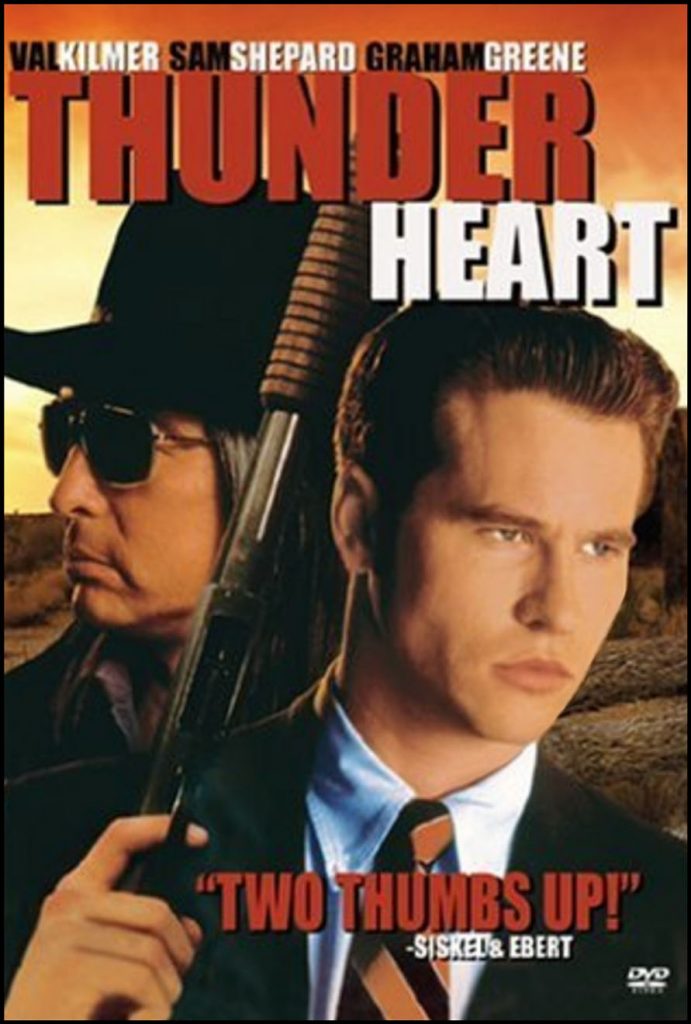
One of the DVD covers for the film.
The reason is simple: Thunderheart has a great plot and screenplay (by John Fusco), deals with a fictional depiction of events that happened on a Lakota reservation in the 1970s, has many characters that grabbed my interest and made me care about them, and shows racism going in both directions. It is a thriller; it is also a tragedy. I can’t spoil the film by telling you what happens, but when it does you’ll cringe and perhaps tear up. I did. I’ve seen Thunderheart at least thirty times (not counting the three screenings for this blog), and each viewing was as alive as when I first saw it. I haven’t talked about the cast, but the leading and most of the supporting players are extraordinary. When I view the film time and again I think to myself that some of them weren’t/aren’t actors—they were/are real people playing roles based upon the tragic reality of their peoples’ lives in modern-time USA. This sentence gives you a hint of what you are going to experience in Thunderheart. It doesn’t matter if this film is number five or number one on my list, for I enjoy it every time I watch it.
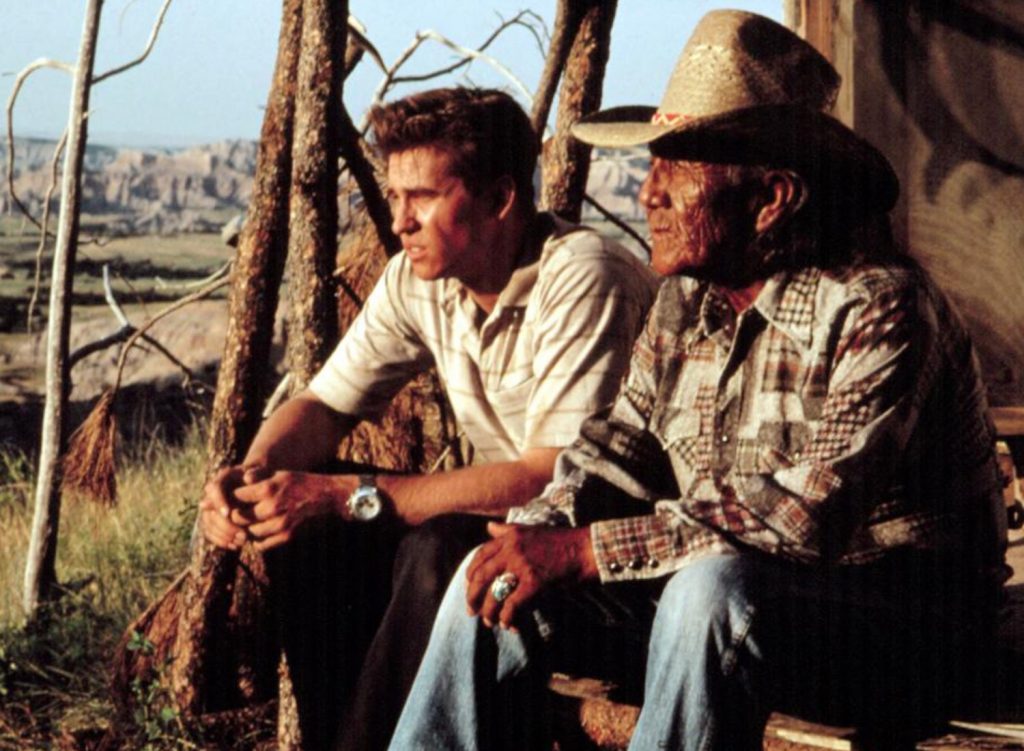
Kilmer is sitting with Chief Ted Thin Elk, who in real life was an elder in the Oglala Lakota tribe. In the film, Thin Elk is also a tribal elder who is at the center of the fictional Sioux reservation. When Kilmer first meets him he is disrespectful but over the course of the film he changes his opinion. LK personal collection.
There are seven key relationships in this film, and all are of major importance: Kilmer/FBI agent Ray Lavoi (who hates that he is quarter Lakota); Shepard/FBI legend Frank Coutelle; Greene/Tribal police officer Walter Crow Horse; Tousey/Maggie Eagle Bear; Ted Thin Elk/Grandpa Sam Reaches; Trudell/Jimmy Looks Twice; and Brave/Grandma Maisy Blue Legs (Tousey’s name should be above the title, and I can make a case for Thin Elk and Trudell also being above the title). Kilmer must deal with all of them once he is assigned to investigate a murder on the rez (reservation); an assignment he abhors but is stuck with it because of his mixed-blood heritage.

During Thunderheart there are many keys that unravel what really happened when a tribal member is murdered on the rez at the beginning of the film. For Kilmer’s part it is a journey that could have never happened if he didn’t follow the trail of clues without an open mind. Here he is presenting Tousey with a ticket from an event that he is certain will reveal who the murderer was. Tousey tells him that it is a piece of paper and that she won’t look into it even though she has access to who bought the tickets. LK personal collection.
Shepard meets Kilmer at the airport and immediately sets Kilmer’s reception and status on the rez in place. “Turn your head to the right,” Shepard drily states. “In the right light you look like Sal Mineo. Did you ever see Arizona Prairie, did you ever see that one?” BTW, this film doesn’t exist and Shepard has delivered a major insult. Mineo was not an American Indian but played one at least twice (in Disney’s Tonka, 1958, and in John Ford’s Cheyenne Autumn, 1964). Still it was enough for Shepard to use him to ridicule Kilmer. It would be worse from the Indian side. Greene calls him out as a “wanna-be Indian,” Tousey dismisses him as the “FBI Indian,” and Drum/Richard Yellow Hawk fries him as the “Washington Redskin.” These relationships are critical to the plot moving forward at an increasing pace until suddenly you are confronted with wolves feasting. It is tragic and gut-wrenching moment, and I love it.

Kilmer, who has slowly sided with Greene, has the proof he needs and brings the tribal police officer to meet the key to what is going on, but it isn’t as it was when he obtained the information. The modern-day cavalry is about to shoot them as their cars charge forward, which is similar to a dream Kilmer had of being at Wounded Knee when the Seventh U.S. Cavalry massacred the Sioux in December 1890 (Greene claims he had a vision). Their end has arrived, … or has it? LK personal collection.
Shelia Tousey was, along with Chief Ted Thin Elk, John Trudell (who, in real life, was an activist for Indian rights), Sarah Brave, Julius Drum, and Graham Greene, perfect casting. She played a university-educated school teacher with children who had returned to the reservation to “help” her people, which also included being raped before the film begins. She is pretty, in control, but there wasn’t a forced relationship between her and Kilmer. Still, and although they were at odds and confrontational throughout most of the film, there is a connection. A connection. We’ve all been there, that is we’ve known people who might have been special but the relationship could never move to fruition for whatever reason.
Best, Thunderheart grabbed me from the moment that Shepard began introducing Kilmer to the reservation. From there it goes in directions that change time and again. This is perhaps the most satisfying film I’m ever seen.
- Miami Vice, directed by Michael Mann and w/Colin Farrell, Gong Li, Jamie Foxx, John Ortiz, Naomie Harris, Luis Tosar, Elizabeth Rodriguez, John Hawkes, Barry Shabaka Henley, and Ciarán Hinds (2006)
I liked the TV series Miami Vice with Don Johnson and Philip Michael Thomas (1984-89, with an unaired episode in January 1990), so when this film opened I was first in line to see it.
This photo of Gong Li dates to Miami Vice. This is an LK image with her signature (not shown). LK personal collection.
This thriller moves at lightning speed, has characters that jump off the screen, and it grabbed me from beginning to end. The TV series? Poof! Gone, never to be seen again. I have never been a fan of Farrell, but his performance was decent, tough, edgy, and by the end of the film, human. But the total surprise of the film was the Chinese actress Gong Li. For her English-language films Li learns her lines phonetically, which makes her performances even more amazing. Of her films on this list only one other is in English.
A drug undercover operation goes bust; agents are killed, and Hawkes/Alonzo Stevens steps in front of big rig in front of Farrell/Sonny Crockett and Foxx/Ricardo Tubbs when he learns that his wife and daughter have been murdered. …
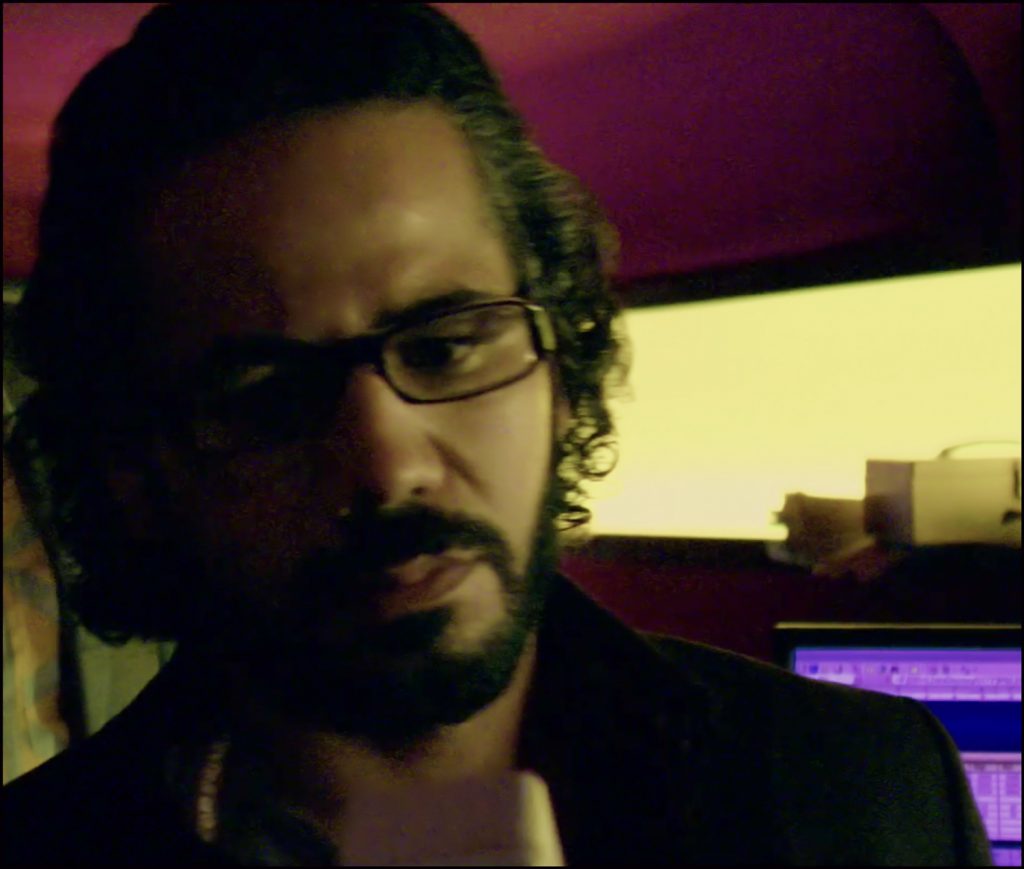
John Ortiz as Jose Yero in one of his computer rooms watching Gong Li/Isabella dance with Colin Farrell/Sonny in a Cuban club in Havana, Florida. He isn’t pleased with what he sees and his discovery will lead to a big twist in the film. LK personal collection.
We see Li for the first time when Florida undercover agents Farrell and Foxx pose as drug dealers who can deliver product in Florida, and maneuver to meet the linchpin who runs operation in the field, Ortiz/Jose Yero. Although Ortiz is not the kingpin of the cartel he is in complete control every time he is on camera. He is a master of the internet and the digital world and controls his domain from his computer rooms at his base or elsewhere when necessary (his performance was charismatic while being frightening). Farrell and Foxx appear to be unarmed when they enter a safe house in a very bad neighborhood way south of the border. It is obvious that they will be lucky to survive the encounter. They do, but it has nothing to have to do with luck. They are as focused, as deadly as Ortiz, and they one-up him. … They also get hired by him.
Li is a silent image sitting in shadow, and the only memory of her is her crossed legs. This was my introduction to an actress who has since become my favorite of all time. Li’s performance was riveting, and I’m terribly understating this here. I could not take my eyes off her whenever she was on camera. This was not because she was beautiful, and she is, but because her natural and yet controlled performance captivated me in every scene.
The film keeps me on edge while multiple characters are in jeopardy throughout. The dialogue is strong and moves the plot while developing all the characters. Yes, this film is a thriller and yet we are involved with almost every one of them, and it is relationship driven.

Colin Farrell and Gong Li in the final scene in Miami Vice. They are outside a safe house and waiting for the boat that will remove her from the here and now. The relationship they had is over (but not dead), this is the present, and there is no future. … Been there and totally understand the moment. LK personal collection.
Again this is a fast moving thriller, sexy beyond belief, but with a multitude of people I liked and cared about—good and evil, and trust me that John Ortiz is the devil incarnate while being so alive that he still resides in a dark area I never want to visit. … Li and Farrell struggle at the climax of the film when he must grab her and yank her to safety or watch her be killed. She is fury on two legs as she lashes out at him. He is stronger and pulls her from the carnage. By the time they reach a deserted building that butts up to a river she has calmed down. Inside the house he turns his back to her and she walks outside. She understands that the reality now controlling her life is inevitable and cannot change. So does he. Great acting. This is my favorite scene on film.
- Blood Diamond, directed by Edward Zwick and w/Leonardo DiCaprio, Djimon Hounsou, Jennifer Connelly, David Harewood, Arnold Vosloo, and Kagiso Kuypers (2006)
This film is absolutely brilliant in oh-so-many ways.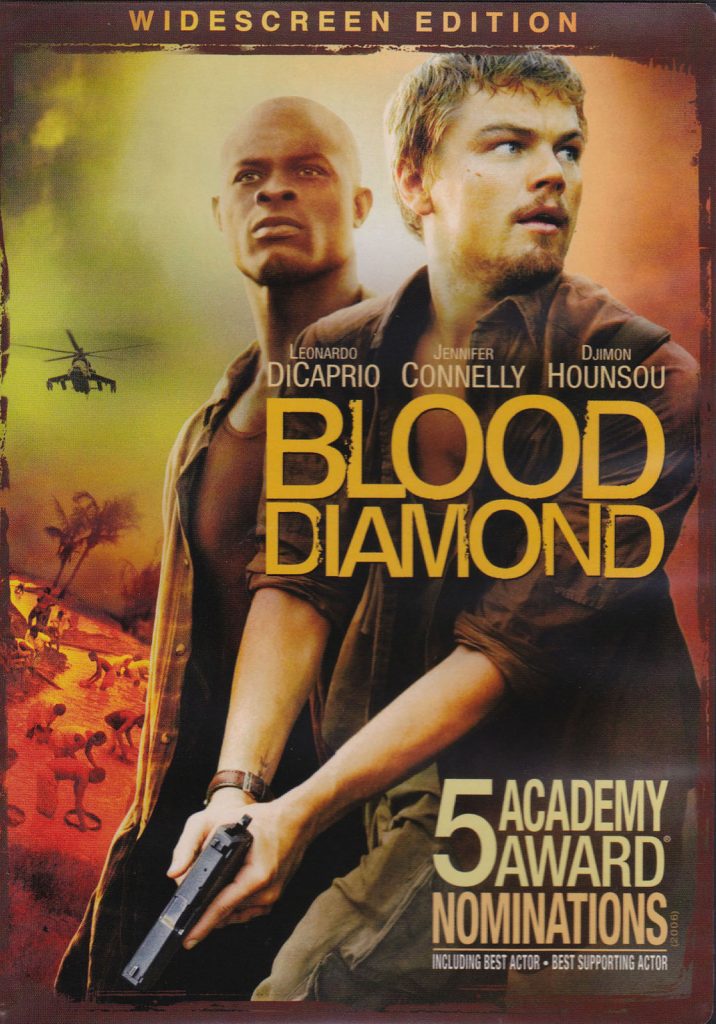
DVD cover for the widescreen edition of Blood Diamond.
It deals with the illegal diamond trade in Sierra Leone, Africa, during the 1990s, racism, and the brutal murder of innocent people during a civil war wherein young boys were abducted and forced to become soldiers and trained to kill. It gives DiCaprio/Danny Archer (a white South African) his best part to date as a smuggler who doesn’t care about anyone or anything but himself; Hounsou/Solomon Vandy (a Black Mende fisherman who loves his family and will do anything to protect them); and Connelly/Maddy Bowen (an American reporter who craves a sensational story that would turn the diamond smuggling world on end).
Without giving too much away, DiCaprio and Hounsou are incarcerated at the beginning of the film.

As Hounsou and Kuypers race toward their family the worst possible happens. LK personal collection.
This began after a good day at school for Kuypers/Dia Vandy (who is Hounsou’s son). He is excited at what he just learned as they walk back to their village. Suddenly rebels in trucks appear in the distance and it is obvious what their destination is. Hounsou forces Kuypers to flee (to no avail) as he attempts to save the rest of his family.

The DiCaprio/Hounsou relationship doesn’t begin well. Worse, war erupts in the city and both run for their lives. LK personal collection.
DiCaprio works for Vosloo/Colonel Coetzee (a big-time diamond smuggler). Unfortunately his latest gig to smuggle diamonds out of Sierra Leone ends badly. Hounsou’s life also sucks for after his village had been destroyed he became a forced worker for an illicit-diamond mining operation that is overseen by Harewood/Captain Poison. When the mining operation is raided Hounsou ends up in the same jail as DiCaprio. Harewood—now minus an eye—soon joins them. All three are separated in large cages of prisoners but can see each other. When Harewood exposes Hounsou for burying a huge diamond DiCaprio is all ears. DiCaprio is released first. When Djimon is set free DiCaprio is ready to strike for this diamond is his ticket out of Africa.
But all isn’t as it should be, and this is the spine of the film. By now most of us are aware of how bad race relations have been in the Land of the Free over the centuries. No matter what my or your opinion is of the USA, it has been much worse on the continent of Africa. Some of what goes on during this small time-grab of history not long in the past is both horrifying and hard to watch.
Hounsou is released from jail but DiCaprio’s forcing a partnership is ill-timed. They are at odds with no common ground. Worse the war has come to them and they must flee or be massacred.
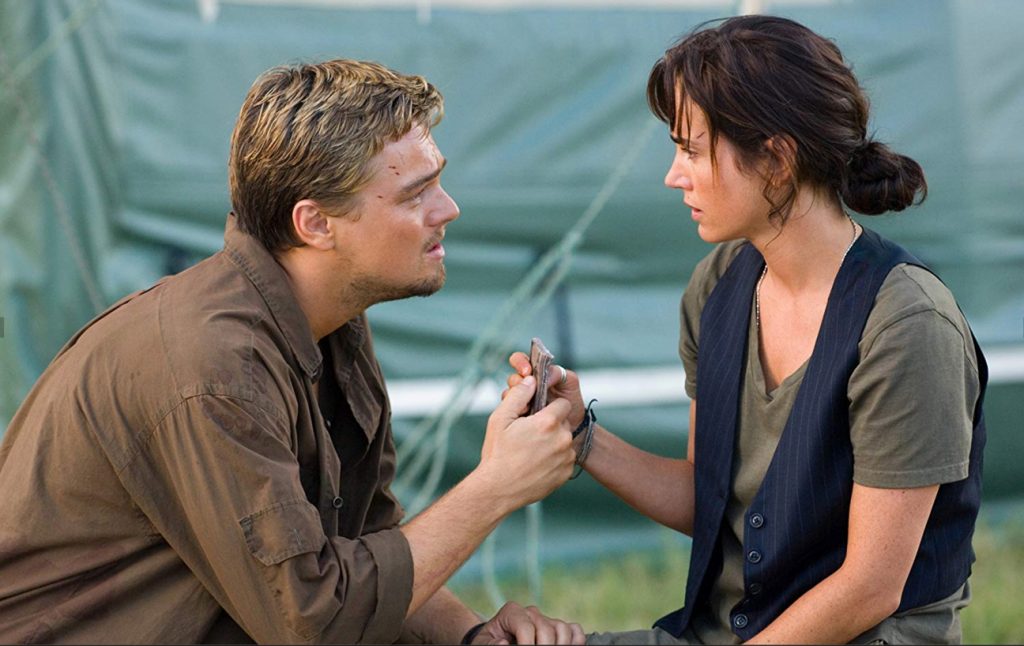
DiCaprio and Connelly in a private moment as he presents her with the information that will shoot her to the front of the newspaper-reporting world. LK personable collection.
Enter Connelly, who oozes sex appeal (but not because she wears slinky clothes as she doesn’t). All business she connects with DiCaprio at an outside bar, but her lone goal is to expose the worldwide diamond trade, which in turn will give her credibility and celebrity. He realizes who she is, and says, “You’re a journalist.” “That’s right.” “Piss off, huh?” he replies. They see each other later at the same bar and while they dance she pushes him, finally saying, “Help me out off the record.” “Well, off the record I like to get kissed before I get fucked, huh,” he replies before walking away. A truer statement was never said. These two people never kiss, DeCaprio is harsh on Hounsou throughout the film, but by the end of it all three of them are human beings worth knowing in a shocking world that I have heard about, read about, but have never experienced. This film has been in my top five for years.
- Nobody’s Fool, directed by Robert Benton and w/Paul Newman, Pruitt Taylor Vince, Jessica Tandy, Dylan Walsh, Alexander Goodwin, Melanie Griffith, Bruce Willis, and Philip Seymour Hoffman (1994)
 Over time more than one person has declared that Paul Newman always played himself. This wasn’t negative, for these people made it clear that Newman was very good at playing himself. … I know this for a fact. In Nobody’s Fool, Newman/Sully struggles with surviving winter with his son’s family (and he’s not welcome), a lady who is his for the asking (Griffith/Toby Roebuck) who works for his sometime employer (Willis/Carl Roebuck), and a fragile woman who rents him a room (Tandy/Miss Beryl). This picture, probably more than most of the other films on this list, is character driven and the results are extraordinary. I can’t say enough about Newman’s sardonic and yet heartfelt performance of a man who meanders through his world of woe (he had been nominated for an Oscar and he should have won, at least in my view). The ups and downs of not only Newman, but of all the people in his life and this includes grandson Goodwin/Will Sullivan. All of them are a delight to behold regardless of their level of misery. Still I don’t want my life to be like Newman’s cinematic life, and yet I do as it is vibrant, in trouble, taking wrong-turns, caring, disappointed, and in love. No matter how bad it gets (and Newman even gets shot at and arrested for driving his pickup on the sidewalk) it is totally up-lifting. Maybe I should show you why.
Over time more than one person has declared that Paul Newman always played himself. This wasn’t negative, for these people made it clear that Newman was very good at playing himself. … I know this for a fact. In Nobody’s Fool, Newman/Sully struggles with surviving winter with his son’s family (and he’s not welcome), a lady who is his for the asking (Griffith/Toby Roebuck) who works for his sometime employer (Willis/Carl Roebuck), and a fragile woman who rents him a room (Tandy/Miss Beryl). This picture, probably more than most of the other films on this list, is character driven and the results are extraordinary. I can’t say enough about Newman’s sardonic and yet heartfelt performance of a man who meanders through his world of woe (he had been nominated for an Oscar and he should have won, at least in my view). The ups and downs of not only Newman, but of all the people in his life and this includes grandson Goodwin/Will Sullivan. All of them are a delight to behold regardless of their level of misery. Still I don’t want my life to be like Newman’s cinematic life, and yet I do as it is vibrant, in trouble, taking wrong-turns, caring, disappointed, and in love. No matter how bad it gets (and Newman even gets shot at and arrested for driving his pickup on the sidewalk) it is totally up-lifting. Maybe I should show you why.

Philip Seymour Hoffman played Officer Raymer. He didn’t like Newman’s Sully and sped his patrol car to a parallel halt in front of Newman as he drove his beat-up pickup on the sidewalk in a residential neighborhood. He’s out of his car in a flash and with his revolver supported by his auto’s roof ordered Newman to stop and get out of the car. When Newman inched toward him, he fired away. The bullets missed Vince/Rub and Newman but shattered the windshield. Newman stopped the truck and walked toward Hoffman, who approached him. You can see what happened, and can guess what followed. LK personal collection.
Maybe I shouldn’t.
I’ve had my run-ins with John Law and they should be documented. Forget the streets for the worst was with LA County Sheriff’s Department Officer Libel. She pronounced her name differently than spelled and didn’t like it when I addressed her as Officer Libel (as spelled). This was in the mid-1980s when I quit acting cold turkey. My sister was then an officer in the Sheriff’s Department and she supported me joining her on the force. Officer Libel took offense at me applying for the position and told me, “I’m going to get you.” “Why?” “We don’t want any actors on the force,” and she did get me. When I told my sister that I was going to go after her in print, she said: “Don’t do it.” “Why?” “Don’t do it.” “Why?” “They’ll get you.” “Why?” “Don’t do it,” was all she’d say. I eventually understood her meaning and walked away from a heinous lie. … And I haven’t even mentioned encounters on the streets. All I’ll say here is that I’m not the goodie-two-shoes you think I am.
Ditto Paul Newman’s Sully. At the same time he’s a giving and caring person (I hope that you’re making the connection here).

Nobody’s Fool takes place in December. It is cold and dark at times. Here Newman is talking with his hired hand and best friend Pruitt Taylor Vince (as Rub Squeers). The best part of their relationship is that Vince has no fear of voicing what he is unsure or unhappy about. When Newman’s grown up son (Dylan Walsh as Peter Sullivan) enters the picture with his own family problems and Newman turns his back on the past and welcomes his reunion with his son Vince fears for his relationship, and this includes a major piece of jealousy. LK personal collection.
Every movie—every movie—should be like this! Like Thunderheart, every time I see this film it is a new experience, and affects me in a different way. … It is a piece of life that all of us experience but in different and yet personal ways. I need to say something about Paul Newman here, and it’s a black mark on LK for I’ve mostly ignored his films over the years. Don’t ask why for I don’t know the answer while at the same time seeing some damned-good performances by him.
I’ve made a point of ignoring the plot for the reason that it is all over the place, and I could never do it justice without giving everything away. I don’t want to do this as this is a film that must be experienced without knowledge of what is coming.
- Red Corner, directed by Jon Avnet and w/Richard Gere, Bai Ling, Tsai Chin (Chairman Xu), Jessey Meng, Tzi Ma, and James Hong (1997)
This film is a nightmare lurking quietly in the dark for any of us who visit foreign countries if you or I make a mistake.
At the beginning of this century my daughter and I were riding in a Paris subway. The
car was empty except for two young women who sat across from us near the rear
exit (two men stayed by the exit and although we couldn’t see them they carried on
a conversation with the women in French. I had some words, enough to know that
they were talking about us. “At the next stop,” I quietly said to my daughter, “we’ll wait
until it’s almost time for the subway to depart. When I tell you, we’re going to rush
to the front exit and get off.” “Why?” “Just do it.” During the stop the women watched us and smiled as they chatted with the still unseen men. “Now,” I whispered and we
dashed to the exit and got off just before the door shut. As the subway pulled away all
four were glaring at us through the windows. …This was nothing compared to what Richard Gere is about to experience.
Businessman Gere/Jack Moore is about to close a major deal with his Chinese partners. Everyone is enjoying themselves in a hotel banquet room, drinking, and watching a fashion show on a ramp. One of the models pointedly makes eye contact with him. He catches her look, and as she is pretty he maintains the contact. After the show has ended Gere notices her glancing at him and drawing something. He excuses himself and crosses to her table and looks at her creation. He points to his nose. “Is that me? My nose?” They’re able to communicate with a few words and gestures.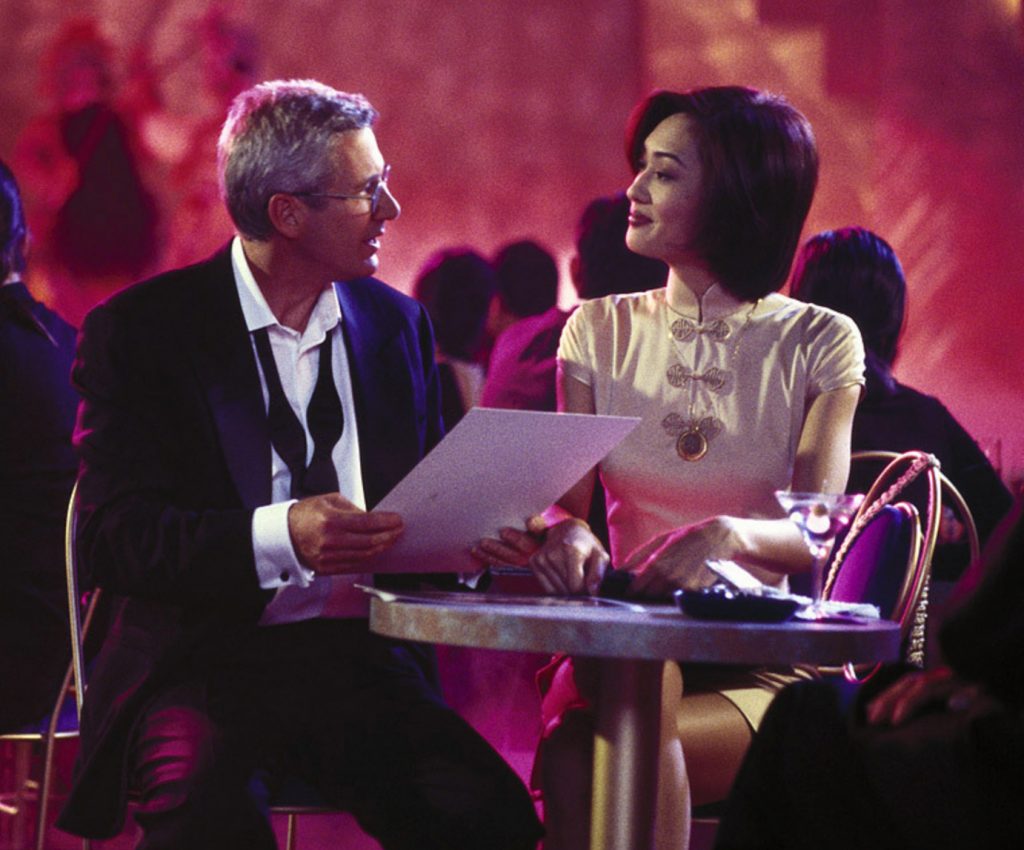
Richard Gere and Jesse Meng easily connect, but it won’t go as either of them expect. LK personal collection.
The conversation flows easily, too easily, and before the evening ends Meng/Hong Ling is in Gere’s hotel room. The night is magical as they enjoy each other’s company.
Morning arrives early—too early—and Chinese police break the hotel door open and charge into the room. Gere is yanked awake. He’s groggy, unaware what has happened or is about to happen. He quickly learns that horrid screams were reported in the night. Gere appears so drunk that it would have been impossible for him to indulge in sex, much less rape and brutally murder Meng. Still, the room is one-huge murder scene. There is blood and gore everywhere, not to mention Meng’s corpse. Three large and empty bottles of alcohol are just part of the evidence (but none of the police ever question how two people could have drank that much without passing out hours before the crime allegedly happened).
The case is open and shut and there is no doubt what the final verdict will be. Ling/Shen Yuelin is assigned to defend the evil Jack Moore. This is the last thing in the world she wants. Ditto Gere when he realizes that his defender considers him guilty. We are now at the point where the story begins.
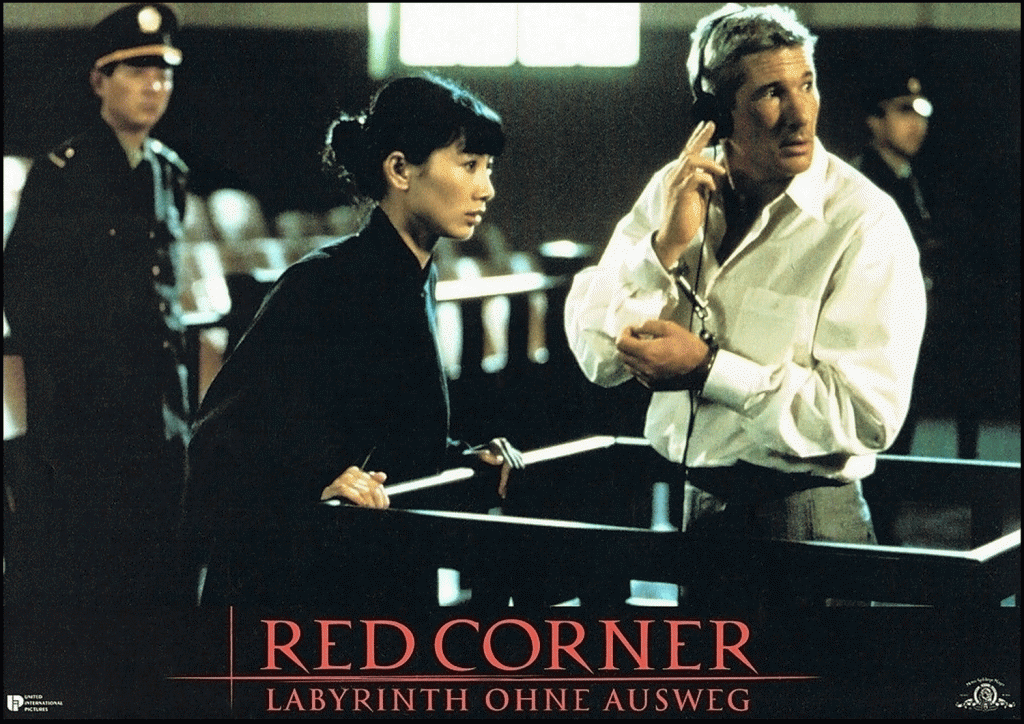
This is a dramatic scene from the film captured in a German lobby card, and the title translates to Red Corner: Labyrinth Without a Way Out. Gere’s character has been accused of murder in China. Bai Ling (center) is his lawyer, and her performance is right there with Gere as the story progresses to conclusion. Unfortunately I have never seen her in anything else although she has been in a number of other movies that might be considered “B” films. Perhaps it is because she had posed nude elsewhere; if yes, she shouldn’t be punished for this. LK personal collection.
With Gere’s arrest and being assigned to Ling the plot of Red Corner moves into the world of racism and shows the consequences of might happen when a person is imprisoned in a foreign country, … and it is brutal.
Hey, folks, take a look at the USA: How many
foreign-born children are going to die in modern-day
concentration camps while separated from their parents,
or simply disappear never to be reunited with their
parents before they are deported?The film is a courtroom drama and a thriller and both genres mix easily.

A free man, Gere is about to board a flight that will return him to the USA. Unfortunately I don’t know the translation of the words. For the record the film never screened in China. LK personal collection.
Unforeseen circumstances lead to Gere’s eventual freedom. This is not to say that Ling’s Shen Yuelin didn’t do everything she could to win in court but her country controlled what she could and could not do.
The scene in the poster is at the end of Red Corner. Like other films in this list the leading characters have come to respect each other, have the beginnings of feelings for each other, but there is no where to go as their lives have different life trajectories.
Perhaps Richard Gere is ignored in the USA and damned in China for something that if you aren’t aware of it you should be: His stance on Tibet and other injustices in our world. KUDOS to him for he dares to speak up about heinous reality. This has not pleased China, and after this film was released he became a persona non grata in both Tibet and China. By the way, the film was shot in the USA.
- Quigley Down Under, directed by Simon Wincer and w/Tom Selleck, Laura San Giacomo, Alan Rickman, Steve Dodd (1990)
This is a western down-under in Australia. Don’t let this fool you for it deals with racism, the butchery of indigent people, and in my opinion contains the best gunfight in all of western film history.
This image of Tom Selleck was taken as he got off the ship that transported him from the USA to Australia. He is good with guns, especially the rifle, and he answered an ad for a gun for hire. This image is almost iconic, and I love what the production company did to move from color to almost grayscale in the photo. LK personal collection.
Selleck/Matthew Quigley was/is just one of numerous actors that starred on TV and then moved successfully to film (Steve McQueen, Clint Eastwood, James Garner, and George Clooney were/are four biggies that made this jump).

Although Laura San Giacomo’s Crazy Cora (left) is tough, a fighter, and a survivor, she is totally in tune with the harsh world that she has been dumped into and reacts to it. Here she is looking at a dead Aboriginal woman that she had connected with. LK personal collection.
What can I say? Quigley Down Under is little more than an American Indian wars story moved to the Australian Outback. Yeah, right. I need to say a few more words, mainly that this is a storyline that shines beyond belief.
The wild and unpredictable prostitute San Giacomo/(aptly named) Crazy Cora and the stoic gunman Selleck are a mismatch from the get-go. Their relationship is hilarious and sad at the same time. Their joining is one that can never work, and we know that in the first reel when Selleck protects her from an escort that are little more than thugs with rape on their minds, and whose function is to deliver her and others to their final destination that are days in the future.

Alan Rickman is perfect as Elliott Marston, a wannabe gunman and all that it entails. LK personal collection.
Journey’s end is the massive ranch that Rickman/Marston lords over. He is also envious and knowledgeable of the gunfighters of the American West, and especially Wild Bill Hickok whom he desperately wants to become the Australian counterpart and this to the point that he envisions himself walking the streets of Dodge City, Kansas, during its heyday. Worse, he yearns to kill a worthy pistoleer in a gunfight. Selleck had no idea what he hired on to do when he reached Rickman’s ranch. He quickly learns when he dines with his racist employer who traffics in people. Aborigines and women, and the former are the reason for his employment.

In this scene from the film Laura San Giacomo holds an Aborigine boy who she rescued from a massacre and has since protected with her life. It is one of many in which we get an inside look at her character as well as Tom Selleck’s. LK personal collection.
Dodd/Kunkurra is Rickman’s token Aborigine man servant and is dressed appropriately for his position. Unfortunately I don’t have any photos of Steve Dodd from the film, and it looks like his acting career and active support of Australian Aborigines was long. He is throughout the film and we get to know him for who he really is despite him performing his duties without a misstep. Actually, we soon see that the entire film focuses on the plight of the Aboriginal people who inhabit the wide open spaces of the never-ending Outback of Australia. Do not doubt that you will see that their lifeway, although on the other side of the world, is similar to the American Indians in that they are looked down upon as less than human and the invading white man would like nothing better than eliminate them. Although there are many Aborigine actors in the film, except for Dodd, their parts are small. At the same time they and what they represent is forever present.

This is a publicity photo of Laura San Giocomo and Tom Selleck near the end of the film. It is one of several taken at this time and is my favorite. LK personal collection.
Even though two people struggling to survive in the middle of a desert without anything but themselves, don’t let this fool you. The intended elimination and butchery of the Aborigines is the focus of the film. It is vivid, heart-rending (the only thing missing is the sexual mutilation of dead victims) and it effects me each viewing as much as it does San Giacomo and Selleck.Selleck quickly realizes he made a mistake sailing to Australia, and this quickly puts him and San Giacomo on the run—two outcasts who don’t get along with no chance of survival. This mismatched farce that joins them at the hip gives both of them plenty of room to explore who they are and what they want. Their relationship is always alive and easily worth 20 viewings of the film.
Although presented upfront the murder of the Aborigines is basically ignored by the British who rule the land as they look down at the Australians and the wild people of the Outback. Racism drips from the screen. Although hinted at but not anticipated a one-on-one gunfight looms—a la Wild Bill Hickok. It is a comin’, and when it happens it does not disappoint. The film stands up fine without a final gunfight, but when Selleck and Rickman face each other it is a classic duel, and my favorite of all time.
- Last of the Mohicans, directed by Michael Mann and w/Daniel Day-Lewis, Madeleine Stowe, Wes Studi, Russell Means, Steven Waddington, Eric Schweig, Jodhi May, and Maurice Roeves (1992)
The first time I saw this film was when my daughter needed to view it for a school assignment and we rented it on video. I was bored to tears and fell asleep.
Daniel Day-Lewis and Madeleine Stowe are the best film duo in what I consider a western film (and that includes Errol Flynn and Olivia de Havilland in They Died with Their Boots On, Warner Bros., 1941). I know, I know—heresy! … But this isn’t so as production values and film have changed over those 51 years. If Flynn and de Havilland played George and Livvie Custer in 1992 it might have been a different LK comment here. We’re talking about place and time. LK personal collection.
A great start (and I’m being sarcastic at myself). … Believe it or not I’ve seen the film many times since then, so I guess that first impressions are not always accurate.

Wes Studi plays Magua, a Huron chief who has aligned with the French during the French and Indian war with the English (between 1754 and 1763). LK personal collection.
All I can say is that the scope of this film, the script (adaptions from James Fenimore Cooper’s novel and Philip Dunne’s 1936 screenplay by John L. Balderston, Paul Perez, and Daniel Moore), the dialogue, the grasp of race (and that includes between the British and the colonists) during the French and Indian war, and acting all gel in such a fusion of reality and fiction that every time I see the film it is an experience.
I need to introduce you to Wes Studi; he’s a great American actor who happens to be a full-blooded Cherokee from Nofire Hollow, Oklahoma. What’s best about the roles he’s played is that he easily moves between being an antagonist and a protagonist. In Last of the Mohicans his Huron Chief Magua is the former as he chose to team with the French. On screen he is focused, intense, totally in control of the moment, dangerous beyond belief, and his character is someone none of us ever want to face when our lives are on the line. This is a terrific portrayal by him and one of numerous performances wherein he brings American Indians to life on screen.
These are real people in real situations, and I don’t care if it is Day-Lewis/Hawkeye, the scout who walks between the races with the father who adopted him; Means/Mohican Chief Chingachgook; the white princess Stowe/Cora Munro who has been sheltered from the world by her father Roeves/Colonel Edward Munro of the British army; her younger sister May/Alice, who falls in love with Chingachgook’s son Schweig/Uncas; and finally the British officer Waddington/Major Duncan Heyward who stood firmly for God and country but becomes heinous when Cora refuses to accept his proposal of marriage. It sounds complicated; it isn’t.

Left: Major Duncan Hayward (Steven Waddington) has offered his life for Hawkeye and his lady’s lives. They run but stop and look back. He is burning at the stake. This cannot be and Hawkeye (Daniel Day-Lewis) ends his life while Cora Munro (Madeleine Stowe) watches. This is not the climax of the film. LK personal collection.
In this film we walk between race and equality time and again. It is alive, explosive, and, even though I have read James Fenimore Cooper’s great novel several times and know the ending I am on the edge of my seat until this film ends, and the final reel explodes in tragedy.

Chingachgook (Means) and Hawkeye (Day-Lewis) look into the distance. They have survived, as has Cora (Stowe), but the chief is now the last Mohican. LK personal collection.
Before walking away from Mr. Means (10nov1939-22oct2012), who was an Oglala Lakota (Sioux), I need to tell you that he played a large role in the creation of the American Indian Movement (AIM), the takeover of the town of Wounded Knee, South Dakota (1973), with Dennis Banks and many others, a standoff with the U.S. government that lasted 71 days (27feb1973–8may1973). Many have cursed Means and those with him during those days that seem a lifetime ago. No! He and AIM were fighting for American Indian rights. This must be praised and not censored.

Daniel Day-Lewis (left), Michael Mann (director), Madeline Stowe, and Russell Means at a premier of Last of the Mohicans in 1993 (but I don’t know where). LK personal collection.
Day-Lewis and Stowe are one of the best film duos in the last 40 years. This said, Errol Flynn and Olivia de Havilland, who played George and Libbie Custer in They Died with Their Boots On (Warner Bros., 1941), are my top film duo for all time, and will forever remain so.
- The Birds, directed by Alfred Hitchcock and w/Rod Taylor, Tippi Hedren, Jessica Tandy, Suzanne Pleshette (as Annie Hayworth), and Veronica Cartwright (1963)
Even though all the advertising pushed Hedren, Alfred Hitchcock’s current “discovery,” this is Rod Taylor’s film.
Rod Taylor/Mitch Brenner begins a relationship with Tippi Hedren/Melanie Daniels in Bodega Bay shortly after they met in a bird shop in San Francisco, when he enjoyed himself at her expense. It was not a good introduction but—there’s also a “but” when a relationship begins. What I really like about this film is its closeness to the Golden Age of Cinema and the inception of what film would become by the end of the 1960s/beginning of the 1970s. LK personal collection.
Mr. Taylor’s charms, as almost always, light up the screen from the moment he appears. More, the story is seen through his eyes, and he dominates this decent reinvention of Daphne du Maurier’s short horror story of birds attacking people on a farm in England. His charm, like fellow Australian Errol Flynn’s, is always present in his films after he became a leading man. Although The Time Machine (1960) would turn him into a star, it was The Birds that would be his film for all time.
Regardless of Tipi Hedren, who was perhaps forced to do things she did not want, being publicized as the lead of the film—she wasn’t. I have heard hints of what most–likely happened between her and director Alfred Hitchcock but have never been privy to this and don’t know the details. Of course I can guess. I met Ms. Hedren once at the end of the 1970s when tigers her from Shambala Preserve, an animal sanctuary created in the early 1970s in Acton, California, were used in a Tom Skerritt TV film, Maneaters [as spelled] are Loose (Mona Productions, 1978), wherein they terrorized a rural community. I had met Tom when I was assigned to work with him on a script he was developing at Theatre West (Studio City, Calif.) in 1969. Before the play went into production he was cast as one of the three leading doctors in MASH (20th Century Fox, 1970), a black comedy about the Vietnam war, and never looked back.
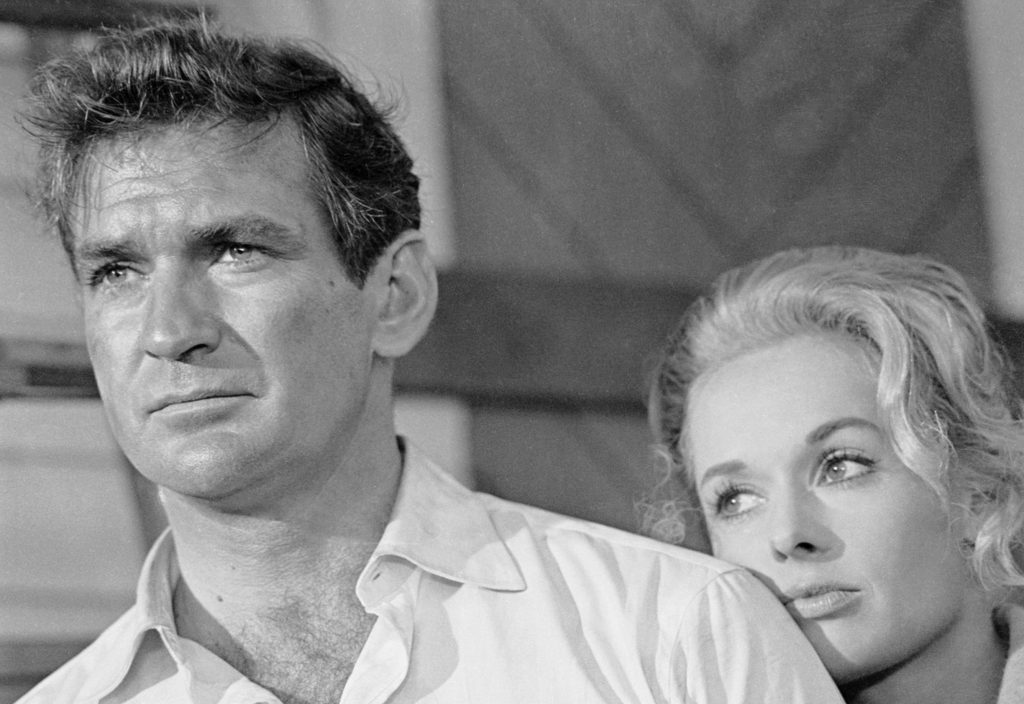
Rod Taylor and Tippi Hedren in one of their many scenes after the birds begin to attack people. Although featured and pretty to look at starlet Hedren had no chance of upending Taylor’s charm and presence in every frame in which he appeared in The Birds. From beginning until the end his persona and performance drove the film to conclusion. Taylor delivered an easy and yet well-defined performance that was key for one of Hitchcock’s best films to succeed. LK personal collection.
The film begins simply when lawyer Taylor is in a bird shop in San Francisco to buy a bird for Cartwright/Cathy Brenner, his young sister’s birthday, who lives in the small Northern California community of Bodega Bay with their mother Tandy/Lydia Brenner. Hedren is present and they clash over the identity of lovebirds. Taylor enjoys the confrontation; her less so. On a whim she buys the lovebirds to deliver to his sister in Bodega Bay, a little more than an hour’s drive north of San Francisco on the California coast (for the record a good part of the film was shot on location). This is just the beginning of a film that is filled with charm, caring, and even love before it slowly dives into a horror that could someday happen—a relationship–centric reality that begins on a light note and slowly gets darker and darker and darker …
The next two films are musts for this list but they shouldn’t be in the number 9 and 10 spots. They are here for one simple reason, and that is
they have played a major role in my life. To be exact they
have impacted over 20 years of my life. - Last of the Dogmen, directed by Tab Murphy and w/Tom Berenger, Barbara Hershey, Steve Reevis (1995)
The story centers on the Cheyenne people (seen or not), and although they are mostly shadows for easily three-fifths of the film they are the focus throughout. This film has been a major part of my life since before 2013 when I finally signed a contract to research and write a book about the Sand Creek massacre. No joke, and I’m as surprised as you, for somewhere around 2010 or 2011 if you asked me if I would write a book about the massacre and mutilation of people who thought they were under the protection of the U.S. government I would have laughed in your face.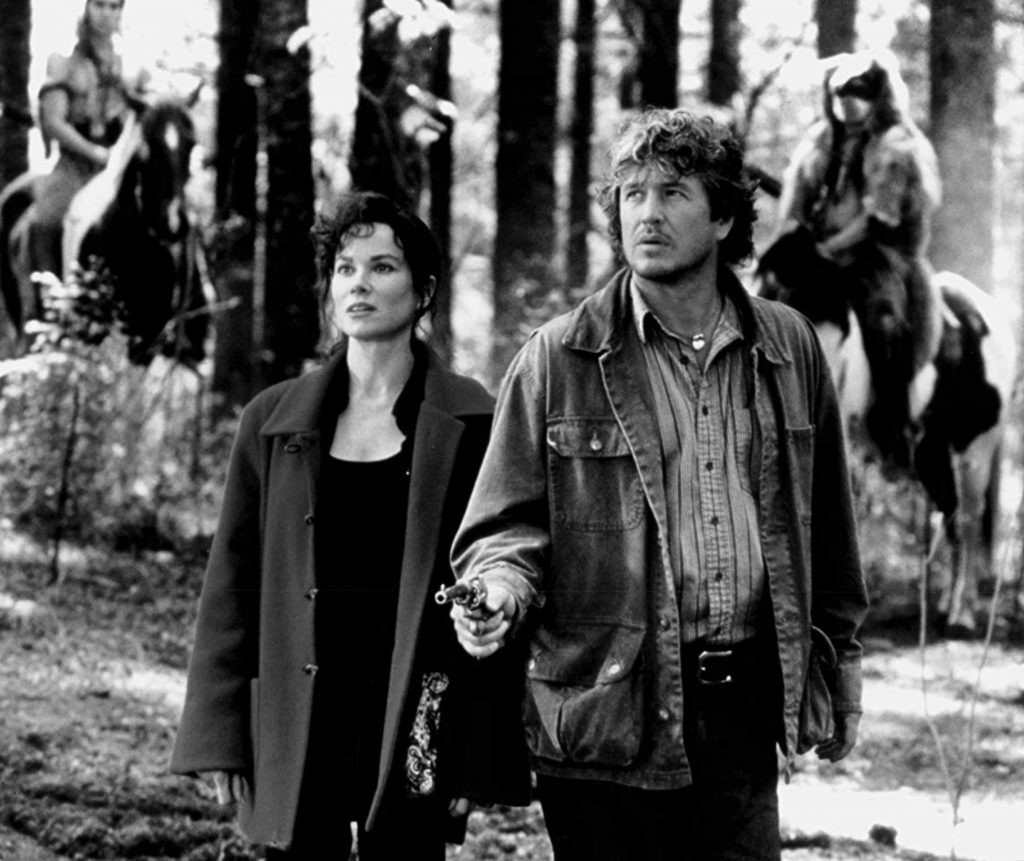
These photos are totally out of order here. Who gives a damn? I don’t. What you see here is Tom Berenger’s fantasy that could never be true; Barbara Hershey’s most magnificent dream becoming reality; and a world of Cheyenne people surviving from 1864 and long into the future undiscovered (Lordy, lordy, … this is a time and place that LK would gladly step into even if he could never return to reality). LK personal collection.
Do not doubt that I have known this film since the beginning for I saw it twice when it premiered in Los Angeles in 1995. Barbara Hershey was already one of my favorite actresses and in my opinion she and Tom Berenger had the perfect chemistry to make this story work. Better, 18 years later the film influenced my decision to buy into a project with such a huge scope that I knew that it would be years before it saw print. Sand Creek and the Tragic End of a Lifeway will be published in spring 2020. Hershey and Berenger’s performances are delightful and I never saw a false moment in their relationship. At the same time I’ve cursed them for all the years they’ve stolen from my life. If not for them, and the magnificent former editor-in-chief at the University of Oklahoma Press, Chuck Rankin, the Sand Creek manuscript would have never happened. Let’s start with Cheyenne Dog Men surviving the massacre of Sand Creek on November 29, 1864, and living undiscovered into the modern world is a great premise (although totally illogic). For the record there were only a small number Dog Men (white man term for the warrior society: Dog Soldiers) at Sand Creek.

Tom Berenger and Barbara Hershey are prisoners of Cheyennes lost in time in Last of the Dogmen. LK personal collection.
The butchery was beyond description and included hacking sexual organs off the dead and using them as ornaments and headbands (this is a fact). Berenger can be evil and he can be charming (I could list a number of his films that didn’t make this list, but could have), … Hershey is one of the best ignored actresses of my time (perhaps because many of her films were B productions, perhaps because she never had a breakout success, perhaps because she did a lot of TV work). I don’t know. This is a lady that I have never met, have no clue to who she really is, and this is disappointing.
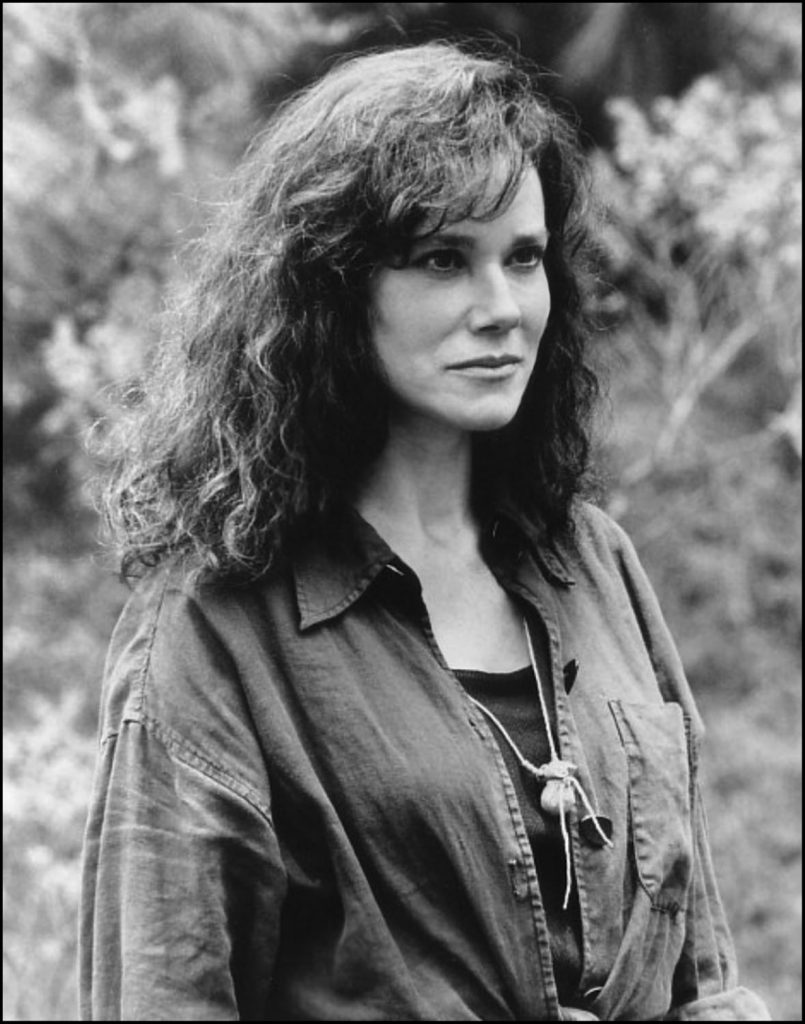
Barbara Hershey in Last of the Dogmen. LK personal collection.
Years back I fantasized that she was a guest on a major nighttime talk show and I was an add-on due a book being published and she tore into me for my view on history. I challenged her to present proof to backup what she claimed. She challenged me to do the same. The host enjoyed the fireworks and invited us both back to continue our personal war. By the second evening Ms. Hershey had read some of my books and backed away from her less than savory view of me. Alas, nothing could happen for by then our history was already fact and couldn’t be rewritten. … I like my history but at times wonder what could have happened if I had turned right instead of left on that long lonely road we all travel.
Berenger is a modern-day bounty hunter and has ridden into a mostly unexplored Montana mountain range called the “Outback” with his dog, Zip (who is a scene stealer), to track down three escaped convicts. All he finds are a few pieces of what once were men and an Indian arrow. One night he sees Indians from the mid-nineteenth century riding in and out of the mist. Or did he? After returning to civilization and needing to know the answer he looks for a university professor and Cheyenne Indian expert on a massive excavation site but can’t find him (that is Professor L. D. Sloan). He is pointed one way and then another and always misses his target. Finally he comes upon two college students who are on both sides of a woman. In frustration he blurts out: “Do any of you know where the old fart L. D. Sloan is?” The two students slowly point at the woman (Hershey), who says: “‘L. D.,’ for ‘Lillian Diane.'” Oops!

One of many photos of Tom Berenger and his horse in the film. He is glaring at Barbara Hershey when she announces that she is joining him in his search for Cheyennes from 1864 living into the present. LK personal collection.
She isn’t impressed with his suggestion that Indians from the past could have survived into the future undetected. Refusing to leave he shows her the arrow. Hershey confirms that it is a Cheyenne Dog Man arrow. “Well?” he pushes, trying to get her to confirm that Cheyennes from times past are living in the Outback. “$12.95 in any gift shop,” she says, dismissing him.
Later, and after Berenger has done research in old newspapers (something that LK does often), Hershey agrees to accompany him into the Outback. He thinks one of her male students is going to join him, and is upset when he realizes that she is going with him. After he complains that the trip is no place for a woman, she checks her saddle and mounts. “Let’s get a move on,” she tells him. “As they say, we’re burnin’ daylight.”
Other than totally enjoying this film while knowing that it could never have happened, there is one scene in it that grabbed me the first time I saw it and it has never let go. It happened one night in the Outback while Hershey and Berenger relaxed in camp after a long day with zero results hunting for the Cheyenne Dogmen.
Put another way, her handful of words are the reason why I decided to sign the contract for the Sand Creek manuscript …. “What happened was inevitable,” Hershey tells him. “The way it happened was unconscionable.”
- Geronimo: An American Legend, directed by Walter Hill and w/Wes Studi, Jason Patric, Gene Hackman, Kevin Tighe, Matt Damon, Robert Duvall, Steve Reevis (Chato), Stephen McHattie, Rino Thunder, Rodney A. Grant, Lee du Broux, and Pato Hoffman (1993)
When this film opened in Los Angeles I saw twice in movie theaters. I liked the scope and grandeur, but not the focus which I thought was all over the place. It should have concentrated on Studi/Geronimo but wandered.
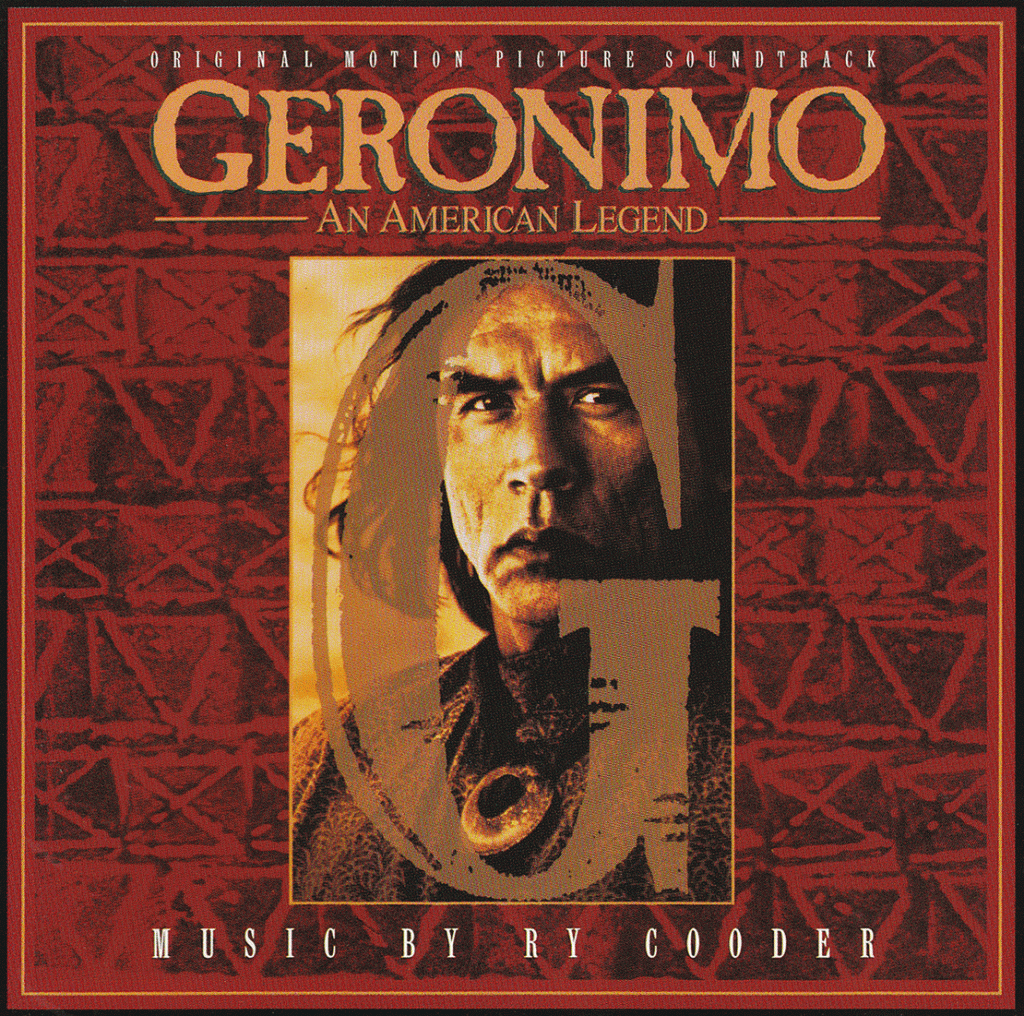 Although this blog isn’t about music I must mention Ry Cooder’s magnificent film score, which was a mix of period music and his original compositions. I have a lot of film scores that I play often, and Mr. Cooder’s soundtrack is my favorite for all time.
Although this blog isn’t about music I must mention Ry Cooder’s magnificent film score, which was a mix of period music and his original compositions. I have a lot of film scores that I play often, and Mr. Cooder’s soundtrack is my favorite for all time.
… At the time I saw the film it was touted as factual. I knew nothing about the war leader/mystic Geronimo (although I did like how the mysticism was worked into the story) or the Chiricahua Apaches. I also knew nothing about the whites who had large roles.
This image is from the beginning of the film when Geronimo and Gatewood hold off a Tucson posse after he returned to the U.S. in February 1884. There are a number of problems with this scene and they are major. 1) When Geronimo returned he was accompanied by 15-16 warriors, some 70 women and children, and a herd of 135 cattle stolen in Mexico. 2) Gatewood wasn’t present although Davis was but he wasn’t a raw recruit right of West Point. 3. There wasn’t a posse (only two government officials, whom Davis and Lt. J. Y.F. Blake got drunk while Geronimo moved northward with his people and stolen cattle). Actually the error list for Geronimo’s return to American soil is extensive. … The above scene shows Studi and Patric scattering the “Tucson” posse and it has decent dialogue and is fun to watch but is little more than pure fiction. LK personal collection.

This is “The Dreamer” (or medicine man?) at Cibicue (think Hoffman but the credits are confusing). It is a small part but it has always stayed with me as he is sympathetic (perhaps read symbolic) while the U.S. officer in charge is brutal and non-listening and pushing the event to violence, which included three Apache scouts turning on the soldiers they served with and which resulted in them hung as traitors. It is the perfect scene to move the story forward. … Or is it? The Cibicue Apaches were/are one of five bands of Western Apaches, of whom the White Mountains were/are the largest and most aggressive (the other three were/are the San Carlos, Northern Tonto and Southern Tonto). More important. Actually MORE IMPORTANT is that that White Mountains and Chiricahuas did not get along to the point that the former often served as Apache scouts for the U.S. in the wars against the hated Chiricahuas. … The incident at Cibicue happened in 1881—three years before Geronimo returned to American soil in 1884 (see above)—and there were no Chiricahuas present and certainly not Geronimo but this tragic incident has Studi present and it shows just how good Geronimo was at surviving while at war. This is good for it gives us a close-up look at Geronimo, but again the Western Apaches were enemies of the Chiricahuas. But—that is BUT—the film continues with its fiction for the next major sequence in it gives us Geronimo’s final breakout from the reservation (1885 from Turkey Creek, which was some 30-35 miles east southeast of Fort Apache, which was located on the White Mountain Indian Reservation. Lordy-lordy, how many missed opportunities could this film present to a movie-going public that was/is clueless? LK personal collection.
The film begins when Geronimo returns to the U.S. from Mexico. Patric’s Gatewood and Damon’s Davis (a raw recruit just out of West Point) travel to the Mexican border to meet him and escort him to the reservation.
Things are about to get complicated in the string of events and their dating that the film covers right through Geronimo’s final surrender. This said, they are dramatic, exciting, and present culture while supposedly documenting the final years of Geronimo and the Chiricahua Apaches freedom. A few examples will show just how mixed up the script was—and again touted as historically correct—while mixing a string of events that weren’t related and at the same time shoving a number of scenes into the film that are right out of paperback western novels sold in grocery stores that romanticize or demonize the taming of the American West.
The killing at Cibicue, as intimated above, led to Geronimo and Naiche’s last outbreak from being prisoners of war and living on a reservation (LK: pure baloney). Naiche was the last hereditary Chiricahua chieftain and during those last years while struggling to remain free they often camped and traveled together, and of great importance were together at the final surrender. His absence from the film is huge (and in my opinion the most heinous error in it).

This scene shows Geronimo (Studi), Nana but called “Old Nana” (Thunder) in the film as the producers probably felt we wouldn’t see his white hair and realize that he was older than Geronimo, and Mangas (Grant) at Turkey Creek. Although not in the film there would be a lot of dissension within the tribe prior to the final breakout and it totally missed the disruption between the Chiricahua leaders and people in regards to if they should flee or not. LK personal collection, and this is my favorite still from the film.

Soon after the breakout Patric/Gatewood led a patrol of soldiers with a handful of Apache scouts. A Chiricahua war party tailed him. Soon the war leader challenged him to a one-on-one duel. This was nicely shot and exciting. In the image Patric realizes what is happening and knows what he must do. LK personal collection.
Prior to the 1885 breakout from Turkey Creek Charles Gatewood commanded patrols of 80 Apache scouts when in the field (a subordinate officer and an interpreter were the only other white men on these patrols; sometimes the interpreters were Apaches). In 1885 the real Gatewood was military commandant of the White Mountain Indian Reservation headquartered at Fort Apache in the mountains to the north of the San Carlos Indian Reservation in the valley far below. Although in the field briefly at the beginning of the outbreak he spent the rest of the war overlooking his wards, the White Mountain Apaches. … No matter for in the film Patric/Gatewood is center stage in two of the most dramatic scenes in the film after Geronimo fled the rez for the last time—scenes that never happened in reality (see the above image for the first one).

As you’ll see directly below I’m not too keen on Bob Duvall’s performance. This image is from the first scene in the film (I have a great shot of him firing away in the Mexican cantina but I didn’t want to use it). LK personal collection.
In the second scene Patric/Gatewood and his totally fictional escort travel into Mexico looking for Geronimo. They stumble upon a destroyed village and see the remains of Indian men, women, and children who weren’t at war but had been murdered and then hacked to pieces by scalphunters. When Patric and escort enter a cantina he sees McHattie/Schoonover, who craves Reevis/Chato’s scalp. This scene reeks of hatred and violence.
Before moving forward I need to share a few thoughts. Hackman/General George Crook and Tighe/General Nelson Miles provide good and believable performances while “Bob” Duvall absolutely sucked as scout Al Sieber (those of you who know anything about Sieber can guess why). I hate myself for saying this as I enjoyed a great three-plus months working closely with Bob in 1980. I can’t say enough good words about the man, the human being who was kind and giving, and one of the most iconic actors of my lifetime (more below when I share a few thoughts about Mr. Patric).

Patric/Gatewood and Studi/Geronimo reach Skeleton Canyon, New Mexico Territory for the final surrender in September 1886 (the actor/characters in the background weren’t present). Unfortunately the entire Geronimo–Gatewood meeting in Sonora, Mexico, that August was total bullshit in the film (the researchers–writers–producers of Geronimo: An American Legend had no clue how dramatic that long one–day meeting between Gatewood, Geronimo, and Naiche was. The film’s loss, our loss, film history’s loss. LK personal collection.
Wes Studi, even though ten–plus years too young to play Geronimo, is brilliant. I’ve always felt this way about his performance because he humanized the war leader/mystic. Geronimo’s name terrorized people in the American Southwest, but that was/is a totally one–sided view. Let’s simply consider the number of wives, number of children, number of family members he lost over his lifetime and ask one question: Why did he do what he did? I know the answer and it’s never going to change. … Not so with Jason Patric’s performance and since 1995 I’ve ripped his portrayal of Gatewood (mainly because I don’t think he did any research other than knowing that the lieutenant was from Virginia). … There have been three films that have played major impacts on my life: Errol Flynn’s The Sea Hawk (1940), Flynn’s They Died with Their Boots On (1941), and Geronimo: An American Legend. If I can remove/ignore the facts in Mr. Flynn’s films I can do it with Mr. Studi and Mr. Patric’s film. When I do this, and it has taken me over two and a half decades to do so, this is a pretty damned good movie. I just told you my view of Wes Studi’s performance. Finally after what feels like forever I can accept Jason Patric playing Gatewood heroically (and ditto Mr. Duvall’s racist performance).
Almost a year and a half after seeing Geronimo: An American Legend I signed Custer and the Cheyenne for Aaron and Ruth Cantor Cohen at Guidon Books in Scottsdale, Arizona. They had always helped me over the years, and on this occasion our conversation turned to western film. Specifically we discussed two films, this one (which did not do well at the box office) and Tombstone (which was a major hit), and how they impacted book sales. Wyatt Earp, Doc Holliday, and the gunfight at the OK Corral saw a major increase in sales whereas Geronimo and the Apache wars did not. I’ve read about Holliday and Earp but I’m never going to write about them. Conversely Gatewood and Geronimo had caught my interest.

LK with a colorized cutout of a photo of Geronimo taken at Canyon de los Embudos in Sonora, Mexico, in 1886, at the Geronimo exhibit, Arizona Historical Society, Tucson, Arizona, on 12feb2012. (photo by Glen Williams and © Louis Kraft and Glen Williams 2012)
Ruth told me that the Gatewood Collection was housed at the Arizona Historical Society in Tucson, Arizona. The following month I took a week off from Infonet (where I was a technical writer) wrapped between two weekends and drove to Tucson. Whoa, cowboy! The following month I took two weeks off wrapped between three weekends. At that time I had begun my next Indian wars book (on Ned Wynkoop), but now it went on hold (as it turned out a ten-year hold, although there were Wynkoop talks, articles, and the beginning of Wynkoop one-man plays). I had discovered an amazing man in Charles Gatewood but it wasn’t enough, and I quickly realized that Geronimo would be the perfect companion in dual biography.
So why is this film on the list?
No Aaron, no Ruth, and no film, … no two LK books:
Gatewood & Geronimo (2000) and
Lt. Charles Gatewood & His Apache Wars Memoir (2005).

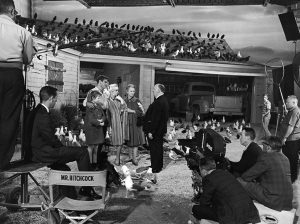


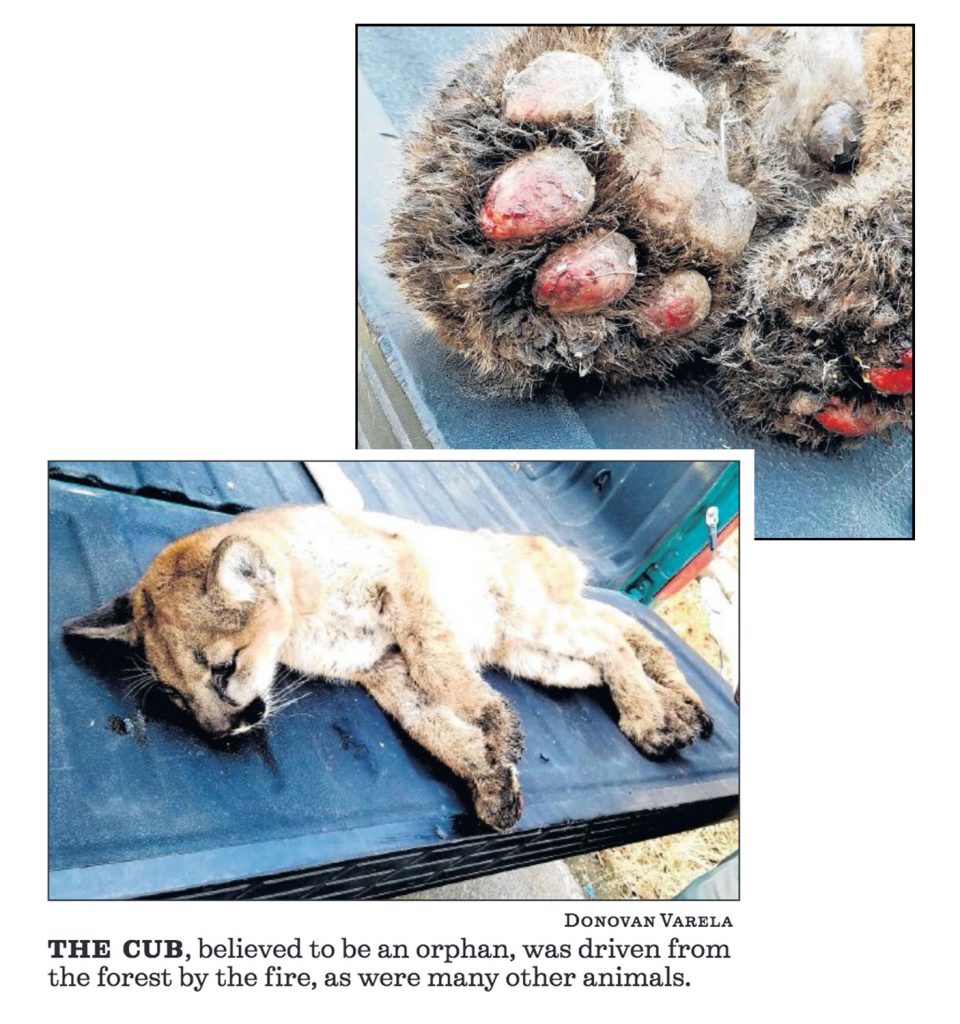
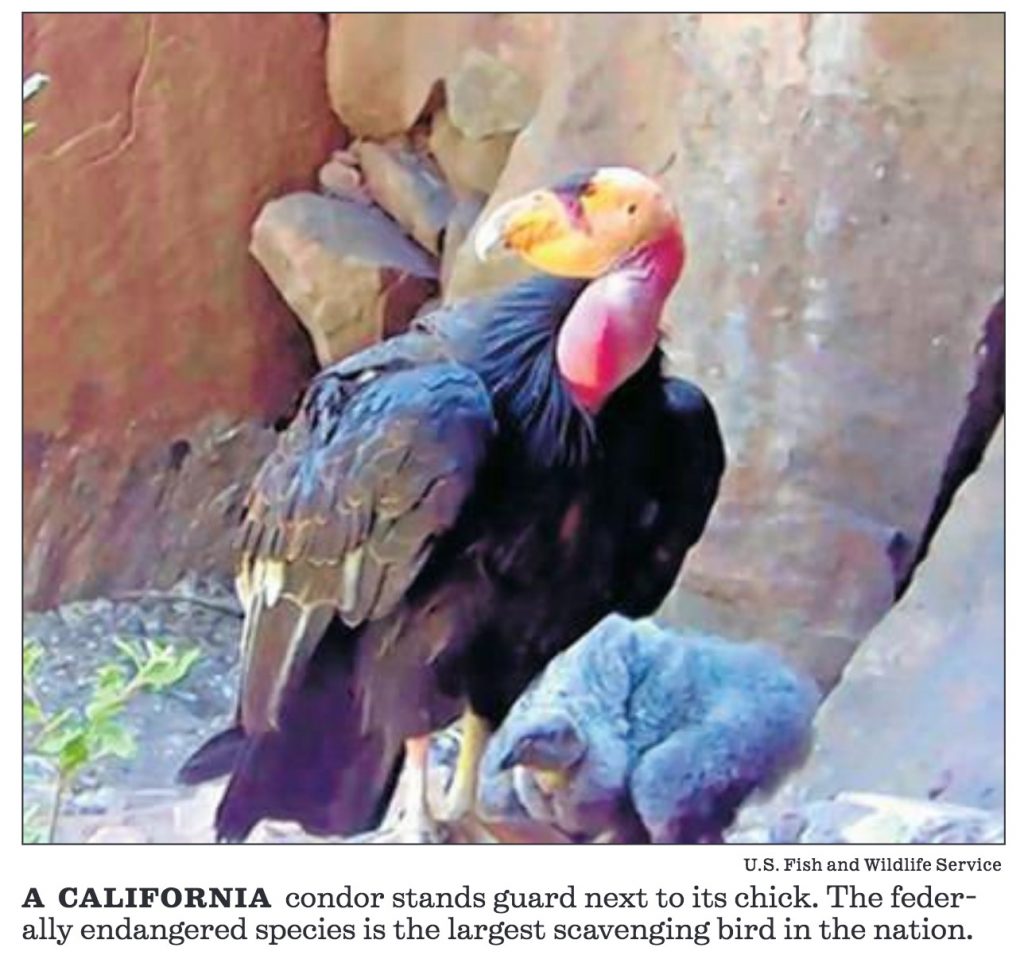
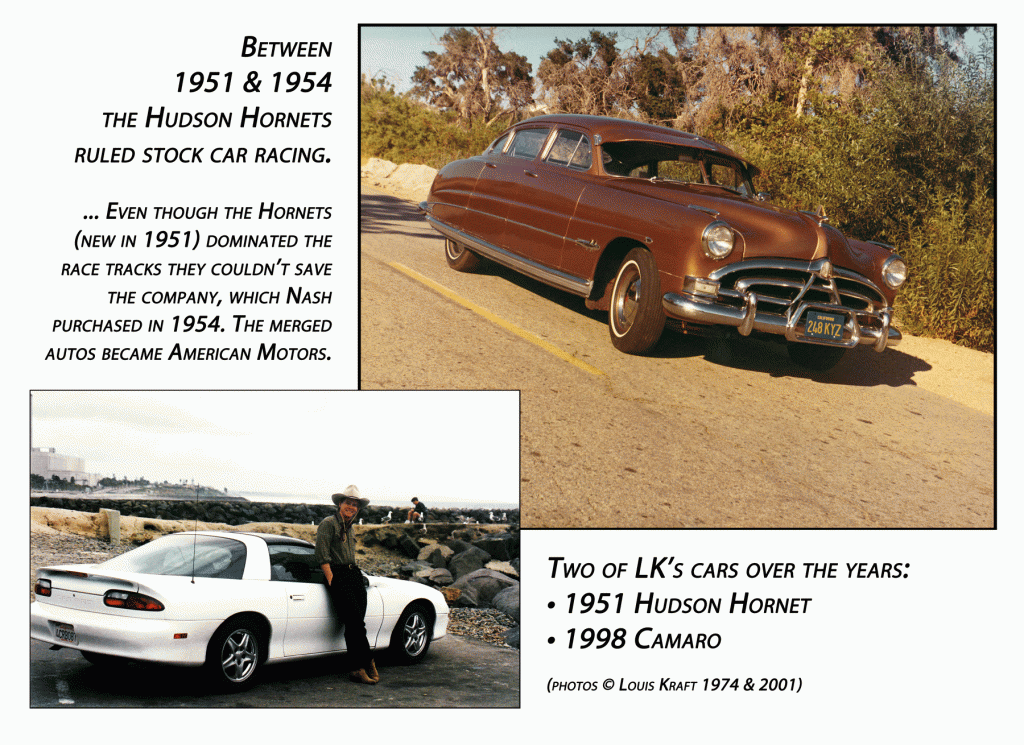

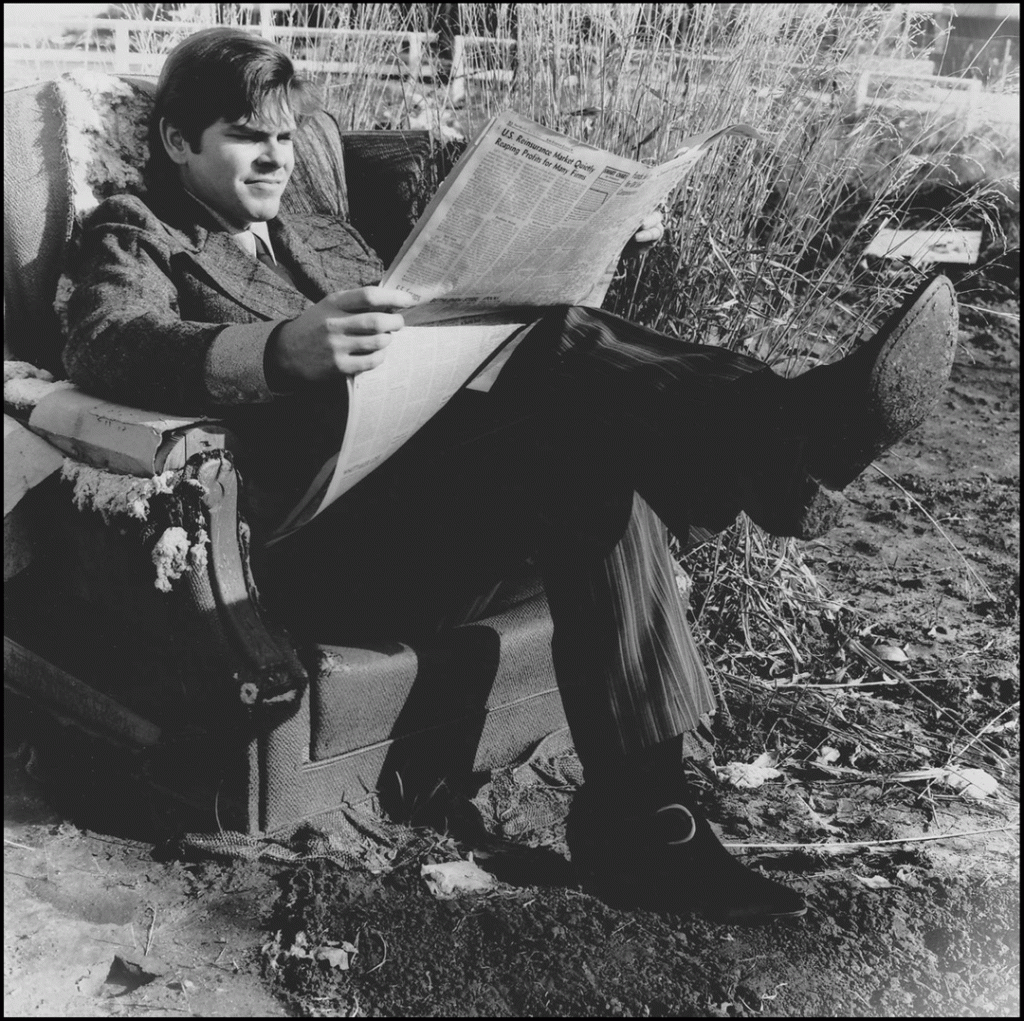





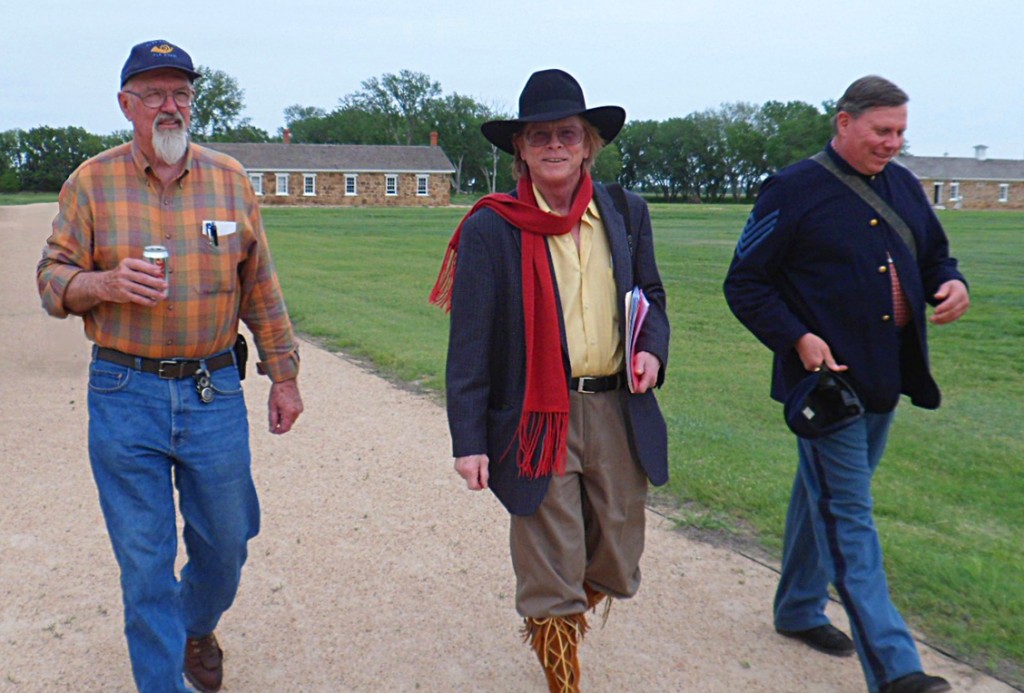
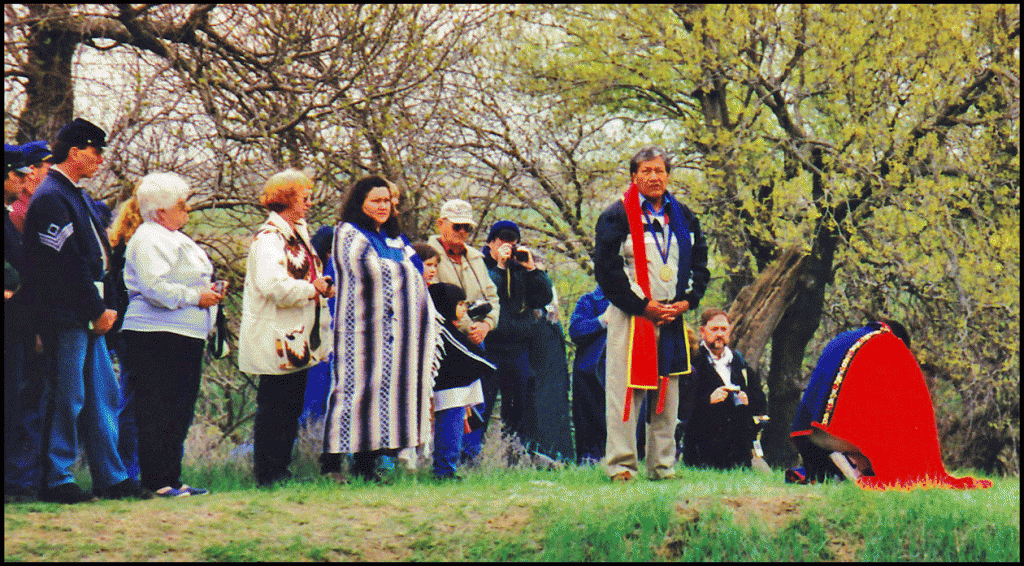
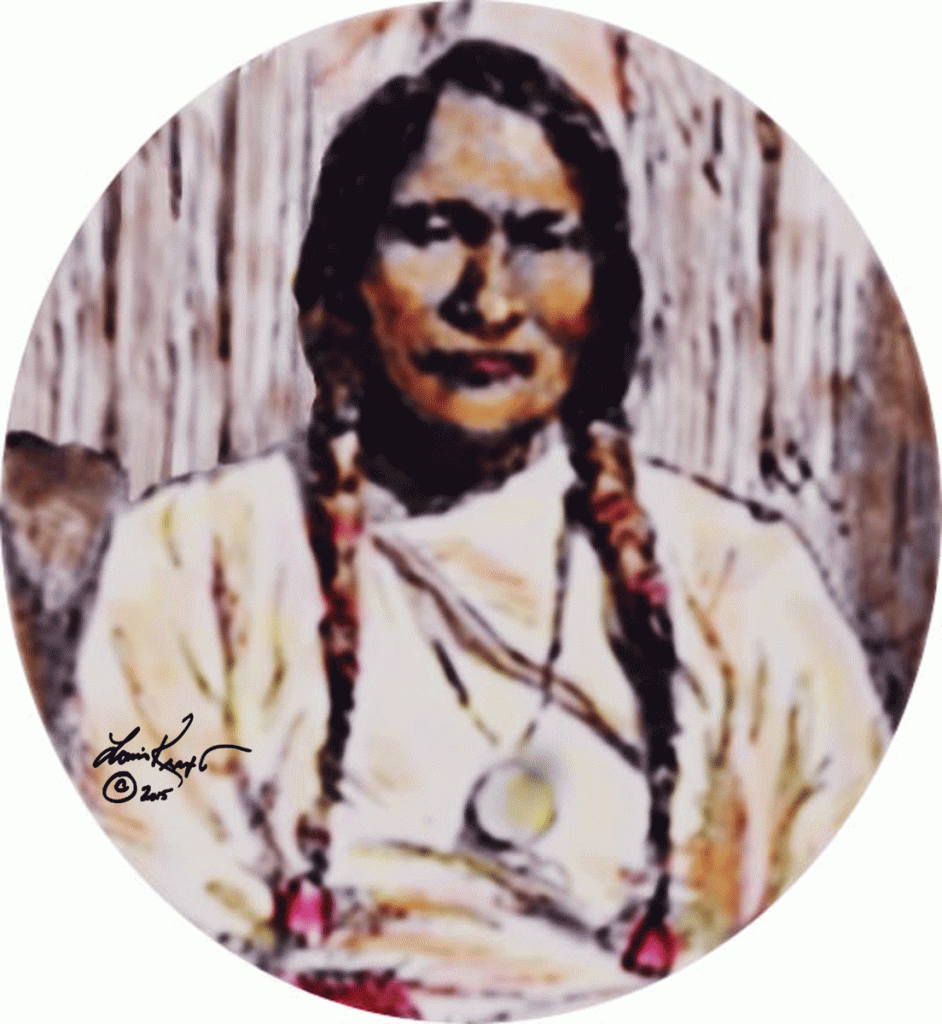

 Is it ethical to sell out truth for greater book sales? Honestly, you don’t want to know my opinion on this. Many writers have done this over the years, and it isn’t confined to the Indian wars. The most infamous—in my opinion—was Charles Higham. Higham, a film biographer, printed despicable lies about two of his subjects (see below), for the simple reason that he wanted to sell books. Other biographers and historians in modern times have mimicked Higham’s practice of creating false facts that bleed red for the same reason, to pocket as many greenbacks as possible. There’s one difference, these hacks of recent times (that is post 1980) stoop so low with their fictional creations that they are little more than cockroaches that run rampant in their readers’ minds as they spread filth that has no basis in reality.
Is it ethical to sell out truth for greater book sales? Honestly, you don’t want to know my opinion on this. Many writers have done this over the years, and it isn’t confined to the Indian wars. The most infamous—in my opinion—was Charles Higham. Higham, a film biographer, printed despicable lies about two of his subjects (see below), for the simple reason that he wanted to sell books. Other biographers and historians in modern times have mimicked Higham’s practice of creating false facts that bleed red for the same reason, to pocket as many greenbacks as possible. There’s one difference, these hacks of recent times (that is post 1980) stoop so low with their fictional creations that they are little more than cockroaches that run rampant in their readers’ minds as they spread filth that has no basis in reality.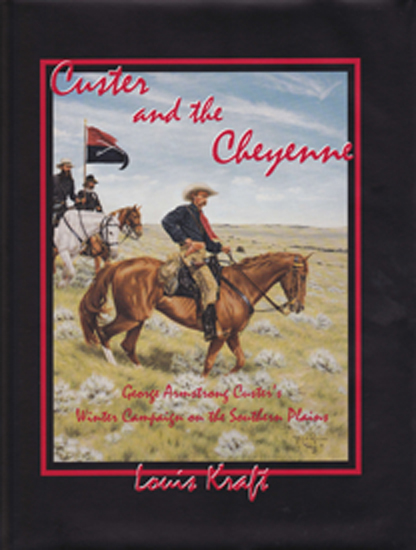 Years passed. It was now 1995 and we were at the Western Writers of America (WWA) convention in Cheyenne, Wyoming (I’m foggy on the location but think the timing was with the publication of Custer and the Cheyenne).
Years passed. It was now 1995 and we were at the Western Writers of America (WWA) convention in Cheyenne, Wyoming (I’m foggy on the location but think the timing was with the publication of Custer and the Cheyenne). Kudos to him for his honesty. At the same time his words now mimic the truth of today’s world. If the truth gets in the way of your preconceived premise, dismiss it. If someone confronts you on your lie, one-up them and call them “little Billy,” or “bullshitting Johnny,” or “sex stalker Alex,” or “lying Donald.” The new key words here are: “Fake News.” Point your finger at them, scream, and if possible see that your hateful rants explode all over social media.
Kudos to him for his honesty. At the same time his words now mimic the truth of today’s world. If the truth gets in the way of your preconceived premise, dismiss it. If someone confronts you on your lie, one-up them and call them “little Billy,” or “bullshitting Johnny,” or “sex stalker Alex,” or “lying Donald.” The new key words here are: “Fake News.” Point your finger at them, scream, and if possible see that your hateful rants explode all over social media.


